Specific work instructions (SWI 142.1.2-5): Forages and grasses seed crop inspection procedures
This page is part of the Guidance Document Repository (GDR).
Looking for related documents?
Search for related documents in the Guidance Document Repository
The purpose of pedigreed seed crop inspection is to provide an unbiased inspection and complete a Report of Seed Crop Inspection for the Canadian Seed Growers' Association (CSGA) on the isolation, condition, and purity of the crop. It is the seed crop inspector's responsibility to describe the crop as observed at the time of inspection.
Updated: April 1, 2023
On this page
- 1.0 Scope
- 2.0 References
- 3.0 Definitions
- 4.0 Specific inspection procedures
- 5.0 Inspection of interspecific or intergeneric grass hybrids
- 6.0 Inspection procedures for hybrid alfalfa
- Appendix I: Process flow diagram for determining number of plants to inspect and the pollen production index of the inspected field:
- Appendix II: Forage crop trait diagrams
- Appendix III: Descriptions of forages and turf grasses
- Appendix IV: Descriptions of forage legumes
1.0 Scope
This Seed Program Specific Work Instruction (SWI) outlines the procedures that a seed crop inspector will follow when inspecting forage, turf, groundcover, native reclamation and related species for pedigreed seed crop status. The crop inspection program ensures that crops grown for pedigreed status meet the requirements for varietal purity and crop standards as specified by the CSGA's Canadian Regulations and Procedures for Pedigreed Seed Crop Production (Circular 6).
2.0 References
The publications referred to in the development of this SWI are those identified in the Seed Program Regulatory Authority Standard (SPRA) 101– Definitions, Acronyms, and References for the Seed Program. In addition, the following were used:
- Pedigreed Forage Seed Production, Canadian Seed Growers' Association, 1996.
- Certification Handbook, Association of Official Seed Certifying Agencies, 1993.
- Forages, Third Edition, M.E. Heath et al., Iowa State University Press, 1978.
- Licensed Varieties of Cultivated Grasses and Legumes, Agriculture Canada, 1974.
- Alberta Forage Manual, Alberta Agriculture, 1981.
- OECD Guidelines for Control Plot Tests and Field Inspection of Seed Crops, OECD, 2001.
- Wild Purple Prairie Clover, Oak Prairie Farm, 2003.
- Dalea candida, White Prairie Clover, Easyliving Wildflowers, 2003.
- White Prairie Clover, John Hilty, 2002.
- Purple Prairie Clover, M. Haddock, 1997.
- United States Department of Agriculture – Natural Resources Conservation Service (USDA-NRCS), The Plants Database (http://plants.usda.gov/plants). National Plant Data Center, Baton Rouge, LA 70874-4490 USA, 2003.
- Agrostis stolonifera, USDA Forest Service (Fire Effects Information System), 2003.
- Creeping Bentgrass Description, University of Illinois Turfgrass Program, 2000.
- Creeping Bentgrass, University of Kentucky, 2003.
- Canary Grass, IENICA, 2003.
- Canarygrass, Putnam et al., 1990.
- Poaceae of the Canadian Arctic Archipelago: Descriptions, Illustrations, Identification, and Information Retrieval. Version: 10th December 2001, S.G. Aiken et al., 1995 onwards.
- Hard Fescue, S. Smoliak et al., 2003.
- Guide to Grasses, Pawnee Buttes Seed Inc., 2001.
- Native plants - Tufted Hairgrass, Washington State University, 2003.
- Tufted Hairgrass, USU Extension, 2002.
- Western Wetland Flora - Field Office Guide to Plant Species, Northern Prairie Wildlife Research Centre, 2003.
- Deschampsia cespitosa, André Bonneau, 2003.
- Slender Wheat Grass, Mississippi National River and Recreational Area, 2002.
- Blue Grama, M. Haddock, 2001.
- Little Bluestem, J. Isaacs, 1992.
- Little Bluestem, Magness et al., 1971.
- Little Bluestem, Sharp Brothers Seed Company, 1999.
- Botanical and Ecological Characteristics (Bromus ciliatus), USDA Forest Service (Fire Effects Information System), 2003.
- Bromus Ciliatus L. Fringed Brome-Grass, West Virginia University Extension Service (Agriculture and Forestry), 2003.
- Green Needle Grass (Stipa viridula), Alberta Prairie Conservation Forum, 2003.
- Stipa viridula, André Bonneau. 2003.
- Needle-and-thread Grass (Stipa comata), S. Smoliak et al., 2003.
- Needle-and-Thread, USU Extension, 2002.
- Beardless Wildrye, S. Smoliak et al., 2003.
- Siberian Wheatgrass, Magness et al., 1971.
- Siberian Wheatgrass, S. Smoliak et al., 2003.
- Alpine Bluegrass, Pawnee Buttes Seed Inc., 2003.
- Alpine Bluegrass, Prairie Seeds, 2003.
- Dahurian Wildrye, in Re-Grassing Farmland: A Practical Guide to Selecting The Right Forage Species, AgriCarta, 1999.
- A general system for coding taxonomic descriptions. Taxon, 29: 41-46, Dallwitz, M.J., 1980.
- User's Guide to DELTA: a general system for processing taxonomic descriptions. 4th ed. Dallwitz, M.J. et al., 1993 onwards.
- User's Guide to Intkey: a Program for Interactive Identification and Information Retrieval. 1st edition. Dallwitz, M.J. et al., 1995 onwards.
- Interactive keys. In Information Technology, Plant Pathology and Biodiversity, pp.201-212. (Eds P. Bridge, P. Jeffries, D.R. Morse, and P.R. Scott.) (CAB International: Wallingford.), Dallwitz, M.J. et al., 2000.
- Flora of the Canadian Arctic Archipelago: Descriptions, Illustrations, Identification and Information Retrieval, Aiken, S.G., et al., 1999 onwards.
- 111 Range and Forage Plants of the Canadian Prairies, Looman, J., 1983.
- Wild Plants of the Canadian Prairies, Best, Keith, F., and Budd, Archibald, C., 1964.
- Common Plants of the Western Rangelands, Tannas, Kathy.
- OECD List of Varieties Eligible for Certification, OECD, 2001.
- Canadian Milkvetch, USDA-NRCS Plants Database. 2002. Plant Fact Sheet. Bismarck Plant Materials Centre Bismarck, North Dakota.
- Chickling Vetch, V.O. Biederbeck and A.J. Leyshon. 1992. Research Branch, Agriculture Canada, Swift Current, Saskatchewan
- Prairie Cordgrass, USDA-NRCS Plants Database. 2002. Plant Fact Sheet. Bismarck Plant Materials Centre Bismarck, North Dakota.
- Indian ricegrass, USDA-NRCS Plants Database. 2002. Plant Fact Sheet. Rose Lake Plant Materials Centre, East Lansing, Michigan.
- Spike Trisetum, Utah State University, Cooperative Extension, 2010, Plant Fact Sheet, Logan, Utah.
- Phacelia tanacetifolia: A brief overview of a potentially useful insectary plant and cover crop. Small Farm Success Project. Fact Sheet. Leslie Gilbert, USDA. 2003.
3.0 Definitions
For the purposes of this SWI, the definitions given in SPRA 101 and the following apply:
- Apomixis
- The development of seed without the fusion of pollen and ovule.
- Cross-pollination
- Fertilization by pollen of another plant.
- Forage crop
- A crop of cultivated plants or plant parts, other than separated grain, produced to be grazed, or harvested to be used as feed for livestock. Grasses to be used in land reclamation also fall under the forage crop category.
- Hybrid
- The first generation progeny of a cross between 2 different plants of the same species often resulting in a plant that is more vigorous and productive than either parent.
- Interspecific hybrid
- Hybrid resulting from two different but closely related species within the same genera being crossed together for example, Meadow Brome is a cross between Bromus inermis and bromus riparius.
- Intergeneric hybrid
- Hybrids resulting from 2 different genera being crossed together, for example, Festulolium as a cross between Festuca pratensis and Lolium perenne.
- Self-pollination
- Fertilization of a plant by its own pollen.
4.0 Specific inspection procedures
Inspection of pedigreed seed crops of forages and grasses should be carried out as described in SWI 142.1.1 – Pedigreed Seed Crop Inspection, with the additional conditions and information provided in this SWI.
4.1 Assessment of the application for seed crop inspection
The application for crop inspection should be reviewed to determine if the crop is eligible for certification based on the age of stand. For perennial crops, CSGA sets standards for the maximum age that a stand/crop may reach and still produce pedigreed seed. The age of stand may be extended with the permission of CSGA on a case by case basis. The breeder may, at their discretion, set ages of stand for crops producing seed of their variety that are different than the CSGA standards. Where this has occurred, the ages of stand are listed on the variety description in the "Additional information" section. If the crop appears to be beyond the allowable age of stand, the inspector can still complete the inspection but may want to discuss the age of stand with the grower who can contact CSGA for verification of the field's eligibility for certification. If a crop was certified the prior year, the expiry year of the field will be accessible on the SeedCert applications tab or in the field application.
The inspector must check tags to verify the pedigree of the seed used for planting but for perennial crops, only needs to verify that information once; usually in first year of inspection.
4.2 Crop inspection
Each grass crop requires inspection at full head emergence, while legumes must be in bloom.
Most forage varieties have the 3 classes established by CSGA: Breeder, Foundation and Certified. In some cases, the Breeder and/or the official seed certification authority in the state or country of origin establishes a Registered class for a particular variety. A list of varieties with a Registered class can be found on SeedCert.
Grass/legume crops should be inspected to the standards of the highest class the field may be eligible to produce, unless the grower specifically request inspection to a lower standard in their application or by using the Form 115 "Intention to Harvest a Specific Class" form available in SeedCert. Factors affecting the class produced include:
- the class of seed used to establish the crop
- seed classes established for the variety
- previous land use
- the age of stand
- isolation
- impurities
When inspecting chickling vetch, the seed crop inspector must report previous land use and isolation distances equivalent to those for lentil, as found in Circular 6, Section 3. The count area when inspecting chickling vetch is based on a 10,000 plant count rather than by area.
When reporting off-types and variants, the seed crop inspector must report 2 characteristics to describe the deviant plant, or note "otherwise conforms" as the second characteristic.
When encountering plants in crops of green wheatgrass that appear to be couchgrass, the plants are to be considered plants of green wheatgrass. However, following green wheatgrass production, the onus will be on the grower to ensure thorough volunteer control. When encountering plants in fields that were previously used to produce green wheatgrass, the plants that appear to be couchgrass have to be reported as couchgrass. The onus is on the grower to present information to the contrary to the CSGA.
4.3 Isolation
Production fields must be isolated from plants of the same species of different or unknown varieties in order to maintain varietal purity. Species must be isolated using distances as prescribed in Circular 6, unless otherwise described in the variety description.
Comments must be made on the crop report to indicate any sources of contaminating pollen within the required isolation distance, including the area, density, stage of maturity and location of the contaminating source relative to the field.
For some crops, growers have 2 alternatives to correct isolation distance discrepancies: border removal in lieu of isolation and the 10% rule.
A grower may choose to remove the border from the inspected grass crop in lieu of a required isolation. However, this requires an arrangement to be made for a second inspection to be conducted. The inspector must ensure that the border was allowed to shed pollen before being discarded. Evidence of the discarded border must be verified at the second inspection. Requirements for border removal in lieu of isolation are further outlined in Circular 6.
For Certified production of alfalfa (including hybrid), timothy and creeping red fescue, an isolation correction may not be required if less than 10% of the field is affected. In the comments section of the crop report, inspectors are required to report dimensions of the contamination in order for CSGA to calculate if the 10% rule is applicable. Diagrams may be necessary to clearly describe the scenario and allow calculations when more than 1 source of contamination is present along the field's edges. Inspectors are not expected to apply the 10% rule themselves on the report of crop inspection. If the varietal isolation is poor, it should always be rated as such even if the 10% rule can be applied. If the Licensed Seed Crop Inspector (LSCI) completes the 10% rule calculation they must show their work and state if the 10% rule can be applied in comments. CSGA will contact the grower and state if the 10% can be applied and provide the isolation requirement. A re-inspection will be required to ensure the isolation correction was made. CSGA produced the "Technical Guideline – 10% Rule" document which should be available to inspectors on SeedCert. The "Technical Guideline – 10% Rule" document focuses on what information is required for CSGA to complete the 10% rule calculation and provides example calculations.
5.0 Inspection of interspecific or intergeneric grass hybrids
When a variety is an intergeneric or interspecific hybrid, it may be difficult to distinguish between the hybrid and either parental species. An example of an intergeneric hybrid is Festulolium which is a cross between Fescue and ryegrass. Examples of interspecific hybrids include hybrid brome grass, hybrid ryegrass and green wheatgrass. Green wheatgrass was developed through hybridization of couchgrass (quackgrass) and beardless wheatgrass.
6.0 Inspection procedures for hybrid alfalfa
This inspection procedure refers to alfalfa hybrids resulting from controlled pollination. It does not refer to interspecific hybrids between Medicago sativa and Medicago falcata.
The only pedigreed class of hybrid alfalfa seed is Certified status. Parental lines used to produce the variety or to maintain a male sterile parent are Breeder or Foundation status. Hybrid alfalfa production may involve the blending of parental seed in specific ratios with the seed of male sterile (female) parent line and either the maintainer line (fertile male for male sterile parent seed production) parent or fertile (male) lines being harvested.
For certified production, a technical blend is a mixture of male sterile (female) parent line and fertile (male) parent line in specific ratios under the supervision of the plant breeder. This is known as a Synthetic Select Seed (CSGA label) and this production is used in lieu of planting the male sterile (female) line and fertile (male) line in bays or rows. Fields may also be seeded in rows alternating between a row of male sterile (female) plants followed by the technical blend of male sterile (female)/fertile (male) plants. When fields are seeded in rows or bays and only the female plants are harvested, then the harvested seed will be of Breeder or Foundation status.
For foundation/breeder parent line production, the male sterile (female) line will be produced in rows or bays with a fertile (male) maintainer line (that is, male sterile x maintainer). The maintainer line parent or fertile (male) lines are produced in the same way as conventional alfalfa fields with only a single line in the field.
Descriptions of the parental lines of registered hybrids are available in CSGA's SeedCert. When conducting an inspection for hybrid alfalfa or the male sterile (female) line, the variety description for both the male sterile (female) and fertile (male) parent of the variety are required.
During field inspection of certified hybrid production, the field must be assessed to determine if the frequency of sterile (female) plants present via the pollen production index method meets the minimum of 75%.
6.1 Pollen production index for certified hybrid alfalfa production
At the time of inspection, the pollen production index (PPI) of the male sterile (female) parent must be determined by examining untripped flowers. The inspector should randomly select areas throughout the field to examine untripped flowers to determine the pollen production index. In each area, trip flowers approximately every step until a total of 200 plants are examined in the field. Consult with the variety representative's CFIA approved hybrid production PPI protocols. Inspectors should verify the presence of bees in a hybrid field as bee activity increases the presence of tripped flowers in the field.
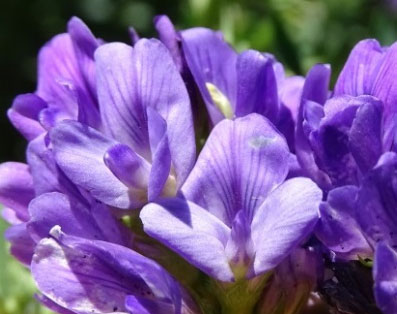
Untripped flowers
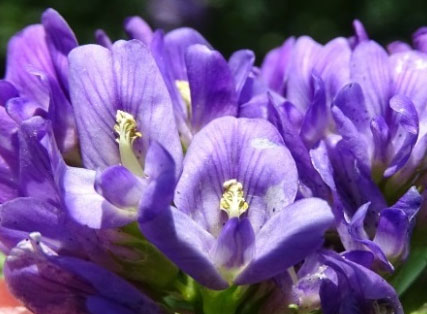
Tripped flowers
Description of hybrid alfalfa photos:
Hybrid alfalfa plant showing tripped and untripped flowers.
Seed crop inspectors must classify each plant as the following:
| Classification | Abbreviation | Description of pollen present | PPI factor |
|---|---|---|---|
| Male Sterile | MS | No pollen present. Anther sacs may be present |
0 |
| Partially Male Sterile | PMS | Trace of pollen | 0.1 |
| Partially Fertile | PF | Substantially less than normal amount of pollen | 0.6 |
| Fertile | F | Normal pollen | 1 |
Description of table determining pollen production index factor for hybrid alfalfa
This table lists the Pollen Production Index (PPI) factor, abbreviations and description of pollen present for Male Sterile (MS), Partially Male Sterile (PMS), Partially Fertile (PF) and Fertile (F) classifications of hybrid alfalfa.
Seed crop inspectors must be careful when examining pollen to determine the level of fertility as empty pollen sacks may be confused with viable pollen. Empty pollen sacks can be found on fully sterile flowers.
If less than 68% of the plants are male sterile, then no further examinations are required because the crop will not meet CSGA requirements. If more than 80% of the plants are male sterile, no further examinations are required because the crop will clearly meet CSGA requirements. If between 68% and 80% of the plants are male sterile, then another 100 plants shall be sampled and included in the calculation.
Calculation for % male sterile plants:
As field examination is completed, the results for inspected crop's pollen production index must be reported on the pollen production index worksheet and submitted along with the completed seed crop inspection report. The inspector should request a copy of the pollen production index worksheet from their Authorized Seed Crop Inspection Service (ASCIS). The information on the worksheet should include documentation of the shape of the field, the travel pattern followed and the location at which plants were examined to obtain the pollen production index.
After examining all required plants (200 or 200 + 100), calculate the pollen production index using the following calculations:
| Number of plants examined | PPI factor | Result |
|---|---|---|
| Total MS | 0 | |
| Total PMS | 0.1 | |
| Total PF | 0.6 | |
| Total F | 1 |
Description of table calculating pollen production index for hybrid alfalfa
This table lists the Pollen Production Index (PPI) calculations based on PPI factor and number of plants examined.
Following are CSGA standards for the maximum allowable pollen production index for different levels of pedigreed production and hybridity.
| Pedigreed status | Type or level of hybridity | PPI |
|---|---|---|
| Foundation | Male Sterile (female) parent | 0.14 |
| Certified | 95% Hybridity | 0.06 |
| Certified | 75% Hybridity | 0.42 |
Description of table of maximum allowable pollen production index
This table shows the maximum allowable pollen production index (PPI) based on type or level of hybridity and pedigreed status.
Refer to appendix I for a process flow diagram explaining hybrid alfalfa inspection procedures.
Appendix I: Process flow diagram for determining number of plants to inspect and the pollen production index of the inspected field:
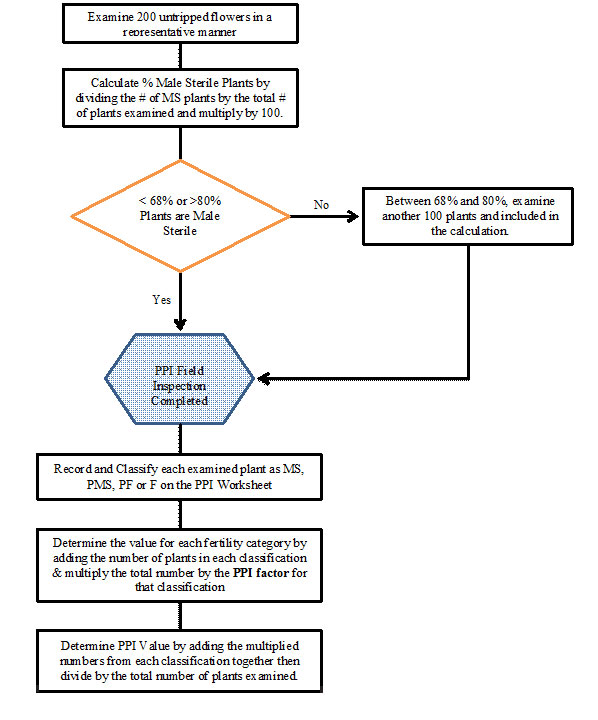
Description of the process flow diagram
The process flow diagram illustrates the steps to follow to determine the number of plants to inspect and the pollen production index of the inspected field.
The first step is the examination of 200 untripped flowers in a representative manner followed by a calculation of the percentage of male sterile plants. The number of male sterile plants is divided by the total number of plants examined and multiplied by 100. If the percentage is between 68% and 80%, 100 more plants have to be examined and included in the calculation. If the percentage is less than 68% or more than 80%, the pollen production index field inspection is completed.
Following the field inspection, there are 3 more steps:
- recording and classifying each examined plant as male sterile, partially male sterile, partially fertile or fertile on the pollen production index worksheet.
- determining the value for each fertility category by adding the number of plants in each classification and multiplying the total number by the pollen production index factor for that classification
- determining the pollen production index value by adding the multiplied numbers from each classification together then dividing by the total number of plants tripped.
Appendix II: Forage crop trait diagrams
The following diagrams have been included to aid in identifying plants. Additional diagrams of each species are included along with the species descriptions in appendix III and appendix IV.
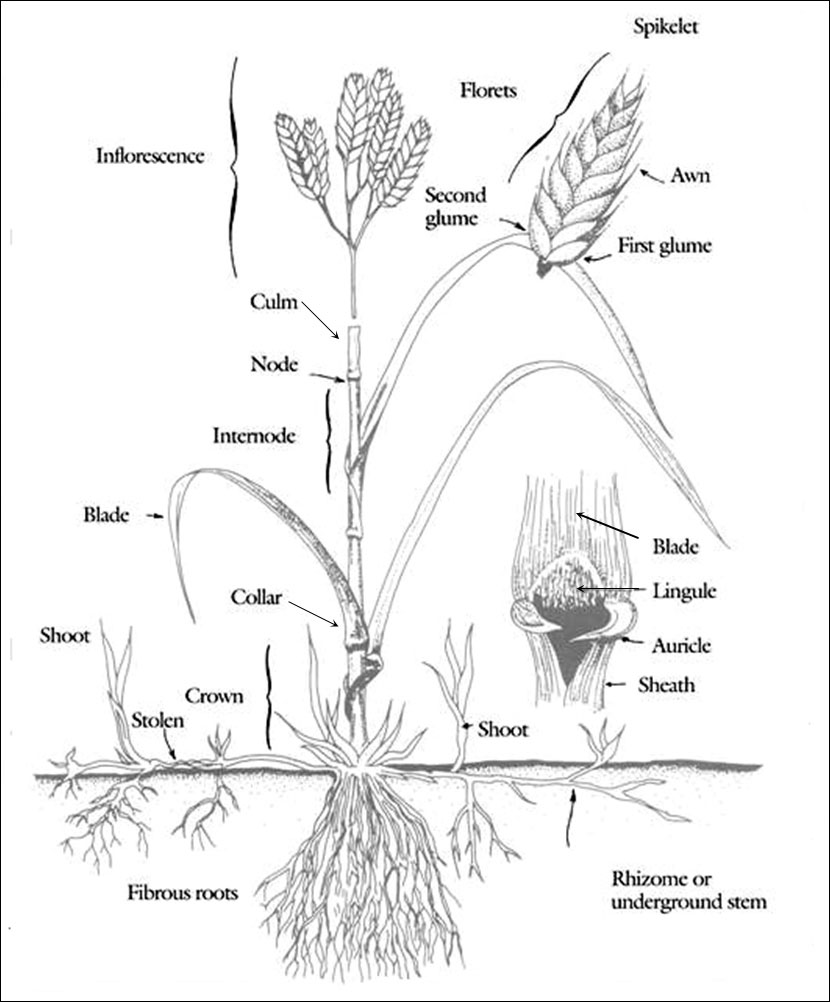
Source: www.for.gov.bc.ca
The Ministry of Forests, Lands, Natural Resource Operations and Rural Development of British Colombia
Description of diagram of grass plant botanical parts
The image shows each botanical part and terms of a typical grass plant including: inflorescence, spikelet, florets, awn, glume, culm, node, internode, blade, collar, crown, shoot, stolen, fibrous roots, rhizome or underground stem, sheath, auricle, and ligule.

Description of diagram of alfalfa leaflet shape
This diagrams shows 4 different alfalfa leaflet shapes: round, ovate, obovate and lanceolate.

Description of diagram of alfalfa pod shape
This diagram shows 4 different alfalfa pod shapes: sickle, crescent-shape in 1 spiral, crescent-shape in 2 spirals and crescent-shape in 3 spirals.

Description of diagram of grass growth habit
This diagram shows 5 different grass growth habits: erect, semi-erect, intermediate, semi-prostrate and prostrate.
Appendix III: Descriptions of forage and turf grasses
The following section describes some inspected forage and turf grass species and native plants in terms of characteristics that may be present at the time of inspection. This section also provides the scientific names of the species as they are listed in the Seeds Regulations.
- Bentgrass
- Blue grama (Bouteloua gracilis)
- Bluegrass
- Bromegrass
- Fescue
- Indian ricegrass (Achnatherum hymenoides)
- Junegrass (Koeleria macrantha)
- Little bluestem (Schizachyrium scoparium)
- Needlegrass
- Orchardgrass (Dactylis glomerata)
- Prairie cordgrass (Spartina pectinata)
- Reed canarygrass (Phalaris arundinacea)
- Ryegrass (Lolium sp.)
- Spike trisetum (Trisetum spicatum)
- Timothy (Phleum pratense)
- Tufted hairgrass (Deschampsia caespitosa)
- Wheatgrass
- Crested wheatgrass (Agropyron cristatum and Agropyron desertorum)
- Green wheatgrass (Elymus hoffmannii)
- Intermediate wheatgrass (Elytrigia intermedia formerly Agropyron intermedium)
- Northern wheatgrass (Elymus lanceolatus formerly Agropyron dasystachyum)
- Pubescent wheatgrass (Agropyron trichophorum)
- Siberian wheatgrass (Agropyron sibericum, Agropyron fragile)
- Slender wheatgrass (Elymus trachycaulus formerly Agropyron trachycaulum)
- Streambank wheatgrass (Elymus lanceolatus formerly Agropyron riparium)
- Tall wheatgrass (Elytrigia elongata formerly Agropyron elongatum)
- Western wheatgrass (Agropyron smithii)
- Wildrye
Bentgrass
Creeping bentgrass (Agrostis palustris, Agrostis stolonifera)
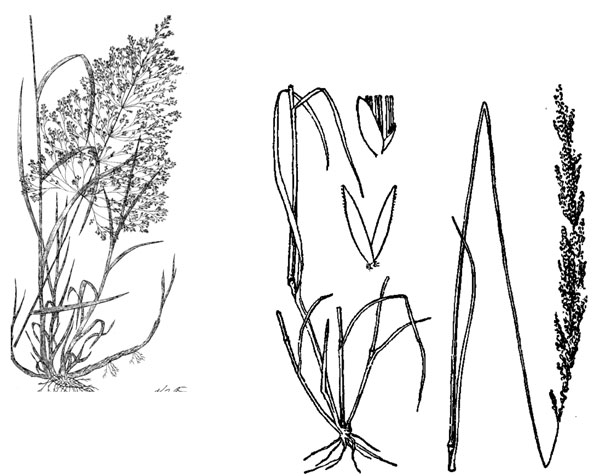
Source: Looman, J. 1983. 111 Range and Forage Plants of the Canadian Prairies. Swift Current, SK: Research Branch, Agriculture Canada.
Description of diagram of creeping bentgrass plant
Illustration of creeping bentgrass showing flower, leaves and roots.
Creeping bentgrass is a cool-season, stoloniferous grass which forms a dense turf. Its culms are prostrate, and grow to 39 cm to 100 cm long. It has blue-green leaves, approximately 3 mm wide and 2 cm to 10 cm long. The short and mostly basal leaves are usually rough on their upper and lower sides as well as the margins. It has no auricles but has a long, tapered ligule. Its stolons are usually white. Like all bentgrasses, its seeds are very small. It's open to somewhat narrow panicle that may reach up to 40 cm in height bears many tiny reddish/ purplish flowers.
Traits useful in distinguishing among varieties:
- leaf colour
- leaf width
- time to inflorescence emergence
Blue grama (Bouteloua gracilis)

Description of diagram of blue grama
Illustration of blue grama showing roots, leaves, sheath and sickle shaped spikes.
Blue grama produces a dense mat of short leaves growing from both short underground tillers and from the crown. The fine, curling basal leaves have a distinct grayish green colour to them. It has very narrow, tapering blades which are 2.5 cm to 17.5 cm long with ligules that are very short having ciliate hairs. The pith-filled stalks grow up to 50 cm in height and usually carry 2 dark brown, sickle shaped spikes, on which the flowers are clustered along the upper sides. Each spikelet contains a perfect floret (contains both the stamen and pistil).
Traits useful in distinguishing varieties:
- plant height
- time to flowering
Bluegrass
Alpine bluegrass (Poa alpina)

Description of diagram of alpine bluegrass plant
Illustration of alpine bluegrass showing leaves, stem and flower.
Alpine bluegrass is an erect, short bunchgrass with culms, growing 20 cm to 60 cm tall. Its flowers are set in a panicle 2.5 cm to 5 cm long. Its leaves are thick and fleshy, and tend to be dark green in colour.
Kentucky bluegrass (Poa pratensis)
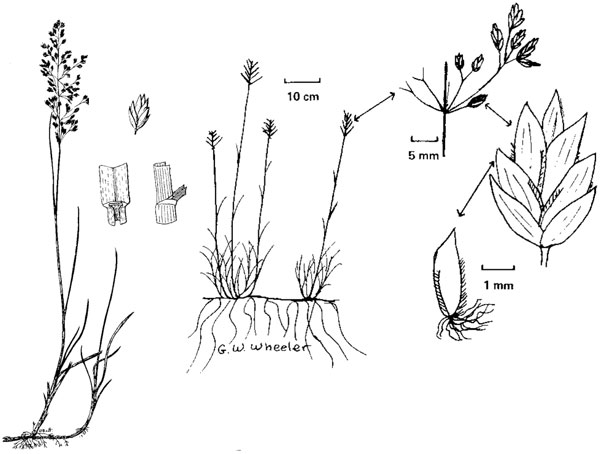
Source: Looman, J. 1983. 111 Range and Forage Plants of the Canadian Prairies.
Swift Current, Saskatchewan: Research Branch, Agriculture Canada.
Description of diagram of Kentucky bluegrass plant
Illustration of Kentucky bluegrass showing creeping roots, leaves, sheath, spikelets and inflorescence.
Kentucky bluegrass is a long lived perennial grass. It has a dense network of creeping and deep feeding roots. The stems are usually 30 cm to 60 cm high, with several in a tuft. Leaves are green to dark green, shiny, smooth, soft, and mostly basal, ranging from 10 cm to 30 cm long, folded in the shoot and boat-shaped at the tip. The ligule is very short and membranous and there is no auricles. Its inflorescence is an open, pyramidal panicle roughly 5 cm to 20 cm long, usually with 5 branches at each node. Of the 5 nodular branches, the centre and outer branches are long and the others are short. The spikelets are 3 to 5 flowered, located primarily at the ends of branches. Each seed has a mat of cobweb-like hairs at its base.
Traits useful in distinguishing among varieties:
- time to inflorescence emergence
- length of longest stem (including inflorescence)
- shape of rachis opposite the lower side branches of the inflorescence
- leaf width; leaf colour intensity
- leaf sheath: anthocyanin colouration
- leaf sheath: density of hairs on both sides, just beneath the leaf blade
- leaf sheath: length of hairs of ligule
- leaf blade: density of fringe hairs on margin of base; density of hairs on upper side
Bromegrass
Fringed bromegrass (Bromus ciliatus)
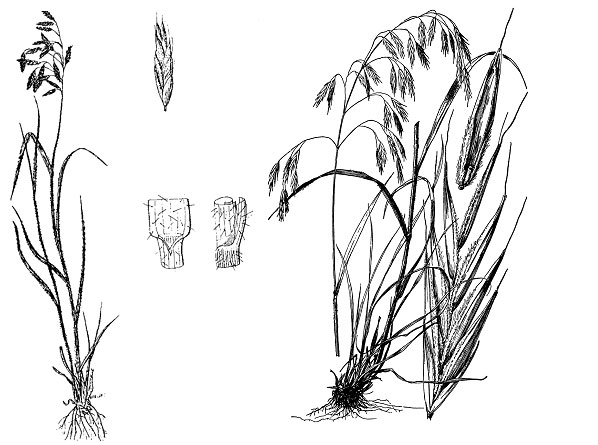
USDA-NRCS Plants Database / Hitchcock, A.S. (rev. A. Chase). 1950. Manual of the grasses of the United States. USDA Miscellaneous Publication No. 200. Washington, DC.
Description of diagram of fringed bromegrass
Illustration of fringed bromegrass showing roots, leaves, and panicle.
Fringed bromegrass is a perennial grass which is normally tufted with a well-developed root system. Its culms are slender and normally reach 50 cm to 125 cm tall. The leaf blades are flat, 15 cm to 25 cm long and 3 mm to 15 mm wide, and normally rolled in the bud-shoot, eventually tapering to a sharp point. The leaves are slightly pubescent and dark green, and have a distinct mid-rib on the lower surface and a slightly ridged upper surface. Its panicle is open, usually between 7 cm to 18 cm long with ascending to drooping branches which hold seeds whose husks are partly or completely covered with short hairs, yet remain awnless.
Traits useful in distinguishing varieties:
- plant height
- time to flowering
Meadow bromegrass (Bromus biebersteinii)
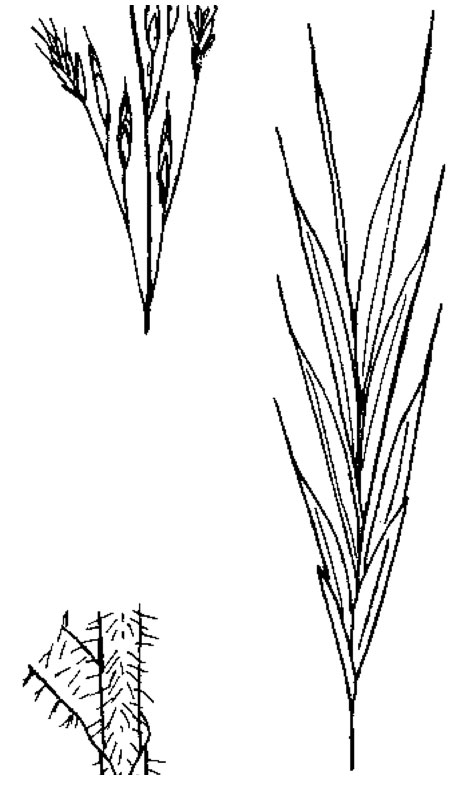
Source: Looman, J. 1983. 111 Range and Forage Plants of the Canadian Prairies.
Swift Current, Saskatchewan: Research Branch, Agriculture Canada.
Description of diagram of meadow bromegrass
Illustration of meadow bromegrass showing pubescent stem and panicle.
Meadow bromegrass is a relatively early maturing, long-lived, densely tufted perennial used for pasture. Its sheath and numerous light green leaves are usually pubescent. The leaves which are predominantly basal are attached to stems that may reach 60 cm to 120 cm in height, with an open panicle at the end. The seed head is 10 cm to 20 cm long, and the seed 10 mm to 12 mm long. The plants head and mature 7 to 10 days earlier than smooth bromegrass.
Traits useful in distinguishing among varieties:
- plant growth habit
- leaf colour
- time to flowering
- plant height
- leaf canopy size
- leaf length
- leaf width
- panicle length
Smooth bromegrass (Bromus inermis)
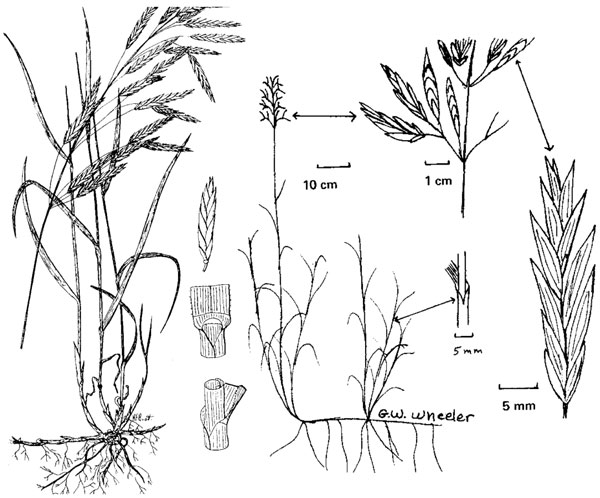
Source: Looman, J. 1983. 111 Range and Forage Plants of the Canadian Prairies.
Swift Current, Saskatchewan: Research Branch, Agriculture Canada.
Description of diagram of smooth bromegrass
Illustration of smooth bromegrass showing rhizome system, sheath, florets and panicle.
Smooth bromegrass is a leafy, cool-season sod-forming perennial that spreads underground by rhizomes and is readily propagated by seed. Its stems are usually between 60 cm to 120 cm long, but only half of the tillers actually produce stems. The basal and stem leaves are tender, broad and long and form a tubular sheath. In early summer, stems are produced on which large, open panicles are found. The panicle type head composed of many florets produces a heavy seed crop. Individual seeds are enclosed in brownish husks that may have a short awn up to 3 mm long. At pollen shed, visible clouds of pollen are disseminated at intervals over several days.
Traits useful in distinguishing among varieties are:
- plant growth habit
- collar shape
- leaf attitude, pubescence, length, sheath colour, and the presence of ligules
- plant height
- flag leaf length and wide
- flag leaf auricle pubescence
- panicle colour, shape and attitude
Fescue
Alpine fescue (Festuca brachyphylla)
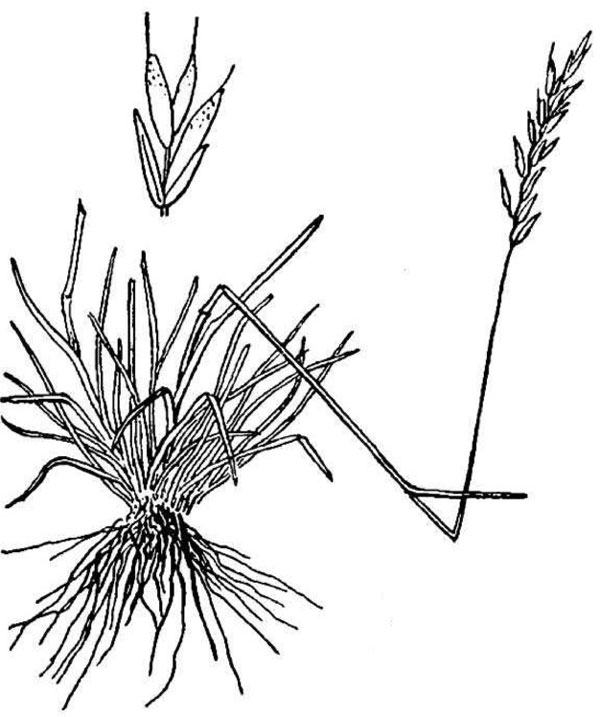
Description of diagram of alpine fescue
Illustration of alpine fescue showing roots, stem, leaves and inflorescence.
The stems usually grow 5 cm to 35 cm high and have an erect growth habit. Its leaves are folded, and mostly in a basal tuft and are blueish-green to yellow-green in colour, possibly with a purple tinge. The leaves are 2 cm to 10 cm long, and 0.1 mm to 2 mm wide when folded. Its sheaths are glabrous or weakly pubescent, and fused only in their lower part, with no auricles. Its inflorescence is paniculate and often spike-like, usually 1.5 cm to 4 cm long and 5 mm to 7 mm wide.
Traits useful in distinguishing among varieties:
- plant height
- time to flowering
Hard fescue (Festuca longifolia, Festuca ovina, Festuca trachyphylla)

Description of diagram of hard fescue
Illustration of hard fescue showing leaves, stem and panicle.
Hard fescue is a cool-season, semi-erect bunchgrass, with leaves 5 cm to 15 cm long. Leaves are greyish-green or pale blue-green, narrow and tightly infolded. Panicles are erect, and can be loose, contracted, oblong or narrow. Seed heads range in length from 2.5 cm to 12.7 cm long. Spikelets have 4 to 9 flowers. Hard fescue produces a significant number of roots, but has no rhizomes and so spreads by tillering.
Traits useful in distinguishing among varieties:
- plant rhizomes
- time to heading
- flag leaf length
- length of longest stem including inflorescence
- length of inflorescence on longest stem
Meadow fescue (Festuca pratensis)
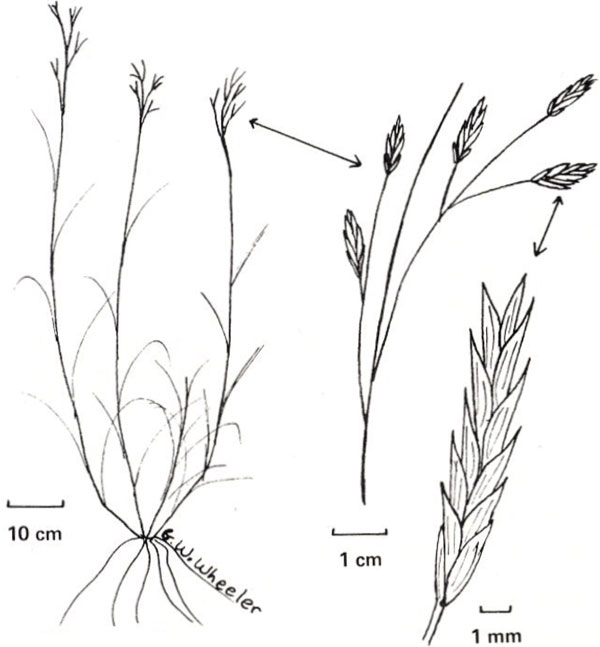
Description of diagram of meadow fescue
Illustration of meadow fescue showing panicle, stem and roots.
Meadow fescue is a short-lived perennial. It grows 40 cm to 75 cm tall and has rather succulent, bright green leaves and leaf sheaths that are smooth and reddish purple at the base. The predominantly basal leaves are glossy on the underside. The panicles of meadow fescue somewhat resemble those of Kentucky bluegrass. It does not propagate by rootstocks or form a heavy sod, but does develop a large number of tough, coarse roots.
Red fescue (Festuca rubra)
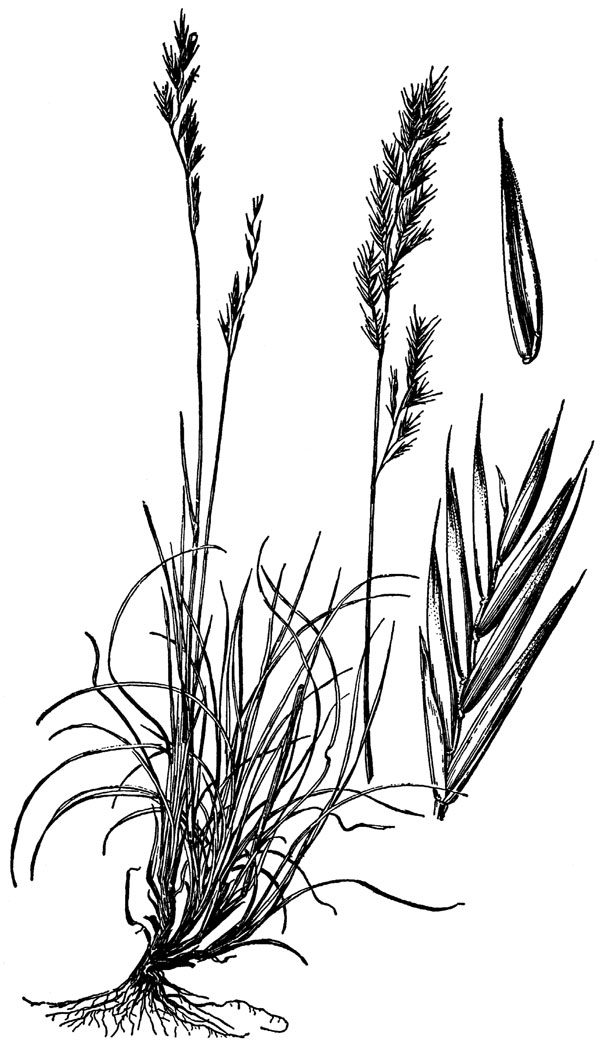
Description of diagram of red fescue
Illustration of red fescue showing roots, leaves, panicle, spikelets and stem.
The 3 distinct forms of red fescue are distinguishable by their creeping habits.
Creeping red fescue spreads by strong rhizomes. Chewings fescue does not possess extensive creeping rootstocks and is therefore tufted and does not spread. The foliage has a finer texture, a brighter green colour, and the seed stems are shorter than those of creeping fescue. The third type is intermediate in stature between creeping and chewings types and forms short rhizomes.
All red fescues have deep feeding roots. The leaves are basal, shiny, folded and bright green, except for the reddish lower sheath. The stems are nearly leafless, shiny and up to 1 m tall for the strongly creeping types. The seed head is a closed panicle with purple-tinged spikelets of awned seed hulls.
Traits useful in distinguishing among varieties are:
- flag leaf length and width
- flowering date
- plant height
- panicle length, shape and attitude
Rocky mountain fescue (Festuca saximontana)
Rocky mountain fescue is a densely tufted perennial with a fibrous root system. The stems are hairless and 10 cm to 50 cm tall. Most of the leaves arise in a basal tuft and are 1 mm wide and 5 cm to 15 cm long. The very slender blades are folded to inroll, hairless and are green in colour. The round to slightly compressed sheaths are split and mostly hairless and smooth, of light green colour with overlapping margins. The basal sheaths are yellow to brown in colour and are persistent. Very short membranous ligules with fringed hairs are present, though no auricles exist. The 2 cm to 10 cm long panicles are linear-lanceolate in shape with erect branches. The 2 mm to 3 mm long lanceolate shaped glumes accompany the 2 mm to 4 mm long lemmas that are roughened on the back with awns 1 mm to 3 mm long.
Sheep fescue (Festuca ovina)

Description of diagram of sheep fescue
Illustration of sheep fescue showing leaves, panicle and florets with long awns.
Sheep fescue closely resembles bluebunch (Idaho) fescue. It is a deep rooted plant with dense basal leafage that is fine, long and of a green colour. It spreads by tufts which grow at the edge of the clumps. The sparse 30 cm to 60 cm long, nearly leafless stems bear a 5 cm to 15 cm closed panicle bearing florets with long awns.
Tall fescue (Festuca arundinacea)

Swift Current, Saskatchewan: Research Branch, Agriculture Canada.
Description of diagram of tall fescue
Illustration of tall fescue showing roots, leaves, sheath, panicle-type head and spikelets.
Tall fescue is a long-lived perennial with an open bunch growth habit having deep, coarse roots and short rhizomes. It has numerous shiny, dark green, ribbed leaves. The branched, panicle-type heads are 10 cm to 30 cm long and borne on seed stalks that are 100 cm to 150 cm in height. Tall fescue produces 5 to 7 short-awned seeds per spikelet that are similar in size and shape to ryegrass but have a purple tinge on the glumes or chaff and a dark purple tinge on the caryopsis. Tall fescue has a number of small hairs on the auricle that do not appear on meadow fescue.
Traits useful in distinguishing among varieties:
- plant growth habit
- plant height
- flag leaf width
- flag leaf length
- time to head emergence
Indian ricegrass (Achnatherum hymenoides)
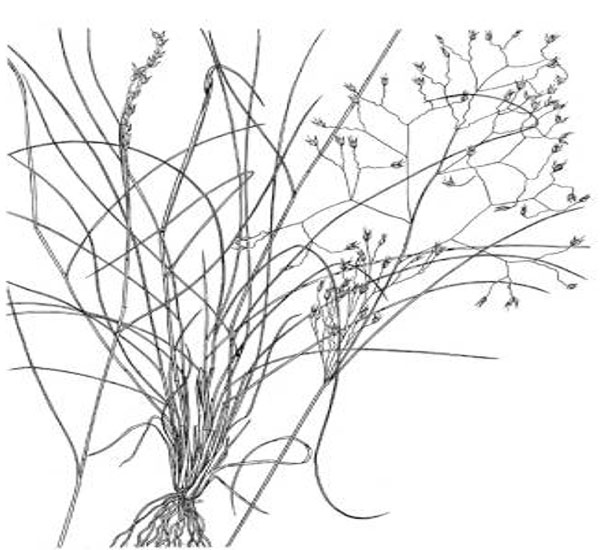
Description of diagram of Indian ricegrass
Illustration of Indian ricegrass showing roots, leaves and panicle.
Indian ricegrass is 8 inches to 30 inches tall. It has many tightly rolled, slender leaves, growing from the base of the bunch giving it a slightly wiry appearance. The ligule is about 6 mm long and acute. It has a wide spreading panicle inflorescence with a single flower at the end of each hair-like branch. Seeds are round to elongated, black or brown, and generally covered with a fringe of short, dense, white callus hairs. Indian ricegrass has fair to good seedling vigour.
Junegrass (Koeleria macrantha)
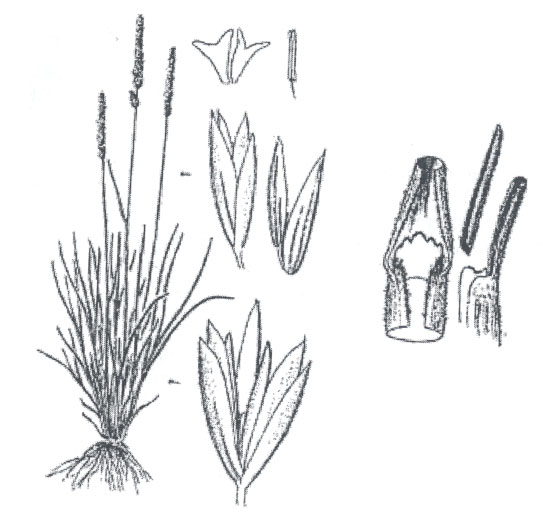
Description of diagram of junegrass
Illustration of junegrass showing roots, leaves, sheath, spikelets and spike-like panicle.
Junegrass is a perennial grass that forms small dense tufts of softly hairy to hairless stems reaching 20 cm to 50 cm tall. The light green to blue-green leaf blades are predominantly basal and are 4 mm wide and 5 cm to 12 cm long, with somewhat boat shaped tips. The leaves are hairless on both surfaces to softly hairy with shiny small hairs. The leaf margins are roughened with narrow white nerves that are folded at emergence. The sheaths are round, split, roughened, somewhat hairy and distinctly veined. The basal sheaths are pale cream-coloured and slightly swollen at the crown. The membranous ligules extend up to 1 mm long and are blunt, often split and are usually fringed with tiny hairs. It has a spike-like panicle that is somewhat open during flowering and is pale green to purplish in colour and 4 cm to 10 cm long. The spikelets usually contain 2 flowers and are 4 mm to 5 mm long. The glumes are 2 mm to 3 mm and 3 mm to 4 mm long and lightly roughened on the keels. The lemmas are often short awned and finely roughened to sparsely hairy.
Little bluestem (Schizachyrium scoparium)

Swift Current, Saskatchewan: Research Branch, Agriculture Canada.
Source: Tannas, Kathy. Common Plants of the Western Rangelands. Volume 1. Lethbridge, Alberta.
Description of diagram of little bluestem
Illustration of little blustem showing roots, sheath, panicle and leaves.
Little bluestem is a warm season bunchgrass with an extensive, dense root system. The pith-filled stems can reach heights of 0.6 m to 1.2 m. Leaves can grow up to 20 cm long, and 6.3 mm wide. Its leaves are flat with fine hairs above the ligules, starting out blue-green but turning a red-brown at maturity or after exposure to frost. Each stem is topped by a single branched panicle which produces hair-covered and awned seeds.
Traits useful in distinguishing among varieties:
- leaf colour
- time to inflorescence emergence
- plant height
Needlegrass
Green needlegrass (Stipa viridula)

Swift Current, Saskatchewan: Research Branch, Agriculture Canada.
Source: Tannas, Kathy. Common Plants of the Western Rangelands. Volume 1. Lethbridge, Alberta.
Description of diagram of green needlegrass
Illustration of green needlegrass showing leaves, roots and panicle.
It is believed to be called "green" needlegrass because, unlike many forages, its seed heads and foliage remain fresh and green through the entire growing season. Green needlegrass is a perennial bunchgrass with small, awned, black, hair coloured seeds that look and feel like needles. It grows to a height of 0.45 m to 1.5 m. Needlegrass has a dense fibrous root system. Its panicle is 10 cm to 20 cm long, compact, with narrow appressed branches. Lemmas are 5 mm to 6 mm long and glumes are 7 mm to 10 mm long. There are white hairs at the junction of the leaf blade and sheath as well as along the edges of the sheath.
Traits useful in distinguishing among varieties:
- plant height
- time to flowering
Needle and thread grass (Stipa comata)
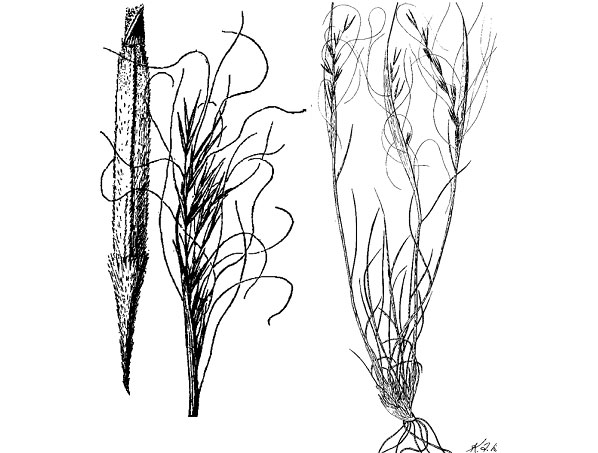
Source: Looman, J. 1983. 111 Range and Forage Plants of the Canadian Prairies.
Swift Current, Saskatchewan: Research Branch, Agriculture Canada.
Description of diagram of needle and thread grass
Illustration of needle and thread grass showing roots, leaves and panicle.
Needle and thread grass is a cool-season native grass, named after the combination of sharp seeds combined with long, bent and twisted thread-like awns. The plant's narrow, green to gray coloured leaves grow in a dense cluster and reach 20 cm to 30 cm in height, and tend to roll in as they mature. It has predominately basal leaves and culms which reach 30 m to 120 m high. Its panicle is 10 cm to 20 cm long and loosely spreading. This grass is characterized by its long, notched and frayed, membranous ligule. It has no auricles.
Traits useful in distinguishing varieties:
- plant height
- time to flowering
Orchardgrass (Dactylis glomerata)

Swift Current, Saskatchewan: Research Branch, Agriculture Canada.
Source: Tannas, Kathy. Common Plants of the Western Rangelands. Volume 1. Lethbridge, Alberta.
Description of diagram of orchardgrass
Illustration of orchardgrass showing roots, sheath, leaves, panicle and spikelets.
Like most other grasses, orchardgrass produces a fibrous root system that is deep and dense, resulting in tussocks. Its shiny leaves are folded in the bud and in cross-section appear v-shaped. Leaf blades are 2 mm to 12 mm wide and may reach a length of 1 m. Leaves vary in colour from light green to dark blue-green. The sheath is compressed and strongly keeled with no auricles. Many leaf characteristics will vary according to the variety and the environmental conditions in which the plant is grown. Although the flowering stems have few leaves, there are many basal leaves. The flowering stems are generally 1 m to 1.7 m high and end in panicles 10 cm to 25 cm long that are composed of spikelets bearing 2 to 5 florets. The lowermost branches of the panicle are longer and more branching than those near the top. In general the panicle is closed, but when open during the short flowering period, it has purplish appearance. The panicle has a distinctive appearance: the flower clusters are borne at the ends of the panicle branches in an asymmetrical pattern, giving the panicle a rather lumpy form. Orchardgrass is also known as "cock's-foot" due to the shape of its seed head.
Traits useful in distinguishing among varieties are:
- plant growth habit
- plant height
- time to maturity
- leaf width and length
Prairie cordgrass (Spartina pectinata)
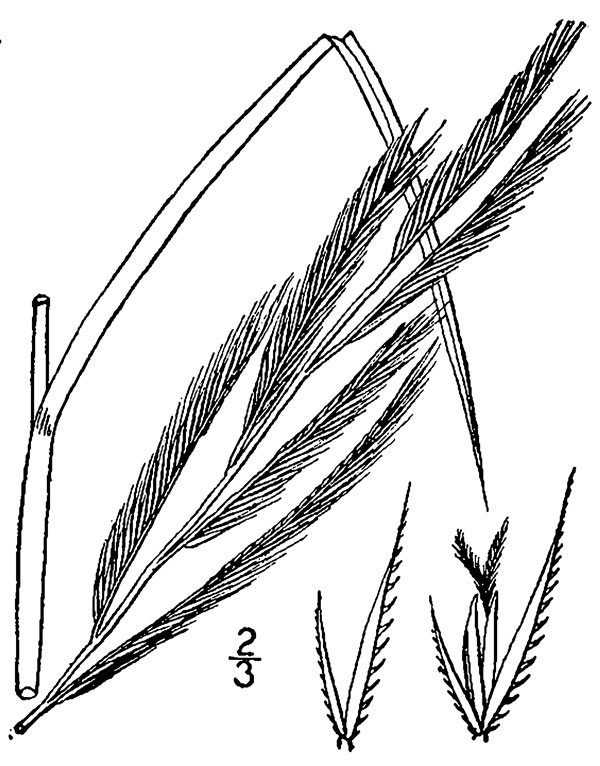
Description of diagram of prairie cordgrass
Illustration of prairie cordgrass showing stem, serrated edge leaves and spike.
Prairie cordgrass is a tall (6 feet to 8 feet), robust, native grass. Strong rhizomes with the ability to grow 5 feet to 10 feet per year separate this grass from other native warm season grasses. An easy characteristic to look for is the sharp, serrated edges of the leaf blade. Seedheads are composed of 10 to 20 spikes attached to the main stem. Each spike has up to 40 spikelets, all growing in 2 rows on the side of the spike away from the stem. The seed typically matures within a week or 2 of frost, and is flat, paper-like with barbed awns that attach firmly to fur or fabric. There are 197,000 seeds per pound.
Reed canarygrass (Phalaris arundinacea)
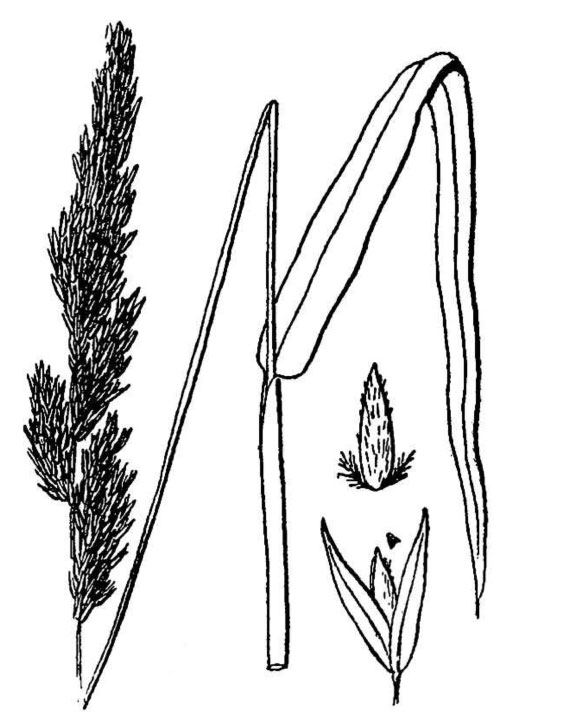
Description of diagram of reed canarygrass
Illustration of reed canarygrass showing wide leaves, spikelets and panicles.
Reed canarygrass (Phalaris arundinacea) is a long-lived perennial which grows in clumps and spreads by underground rhizomes and stands between 60 cm and 240 cm tall. It has deep feeding roots and leafy stems thick enough to prevent most lodging, and long, wide, light green basal leaves. Its flowers are borne in semidense, spikelike panicles 5 cm to 20 cm in length. Many spikelets containing only 1 formed seed grow on each branch of the head. The seeds are shiny brown and narrow and as long as flax seeds. Note that canary seed (Phalaris canariensis) is classified as a small grain, and information regarding this crop can be found in SWI 142.1.2-2.
Traits useful in distinguishing among varieties:
- plant height
- leaf length
- leaf width
- time to head emergence
- head length
- head shape
Ryegrass (Lolium sp.)
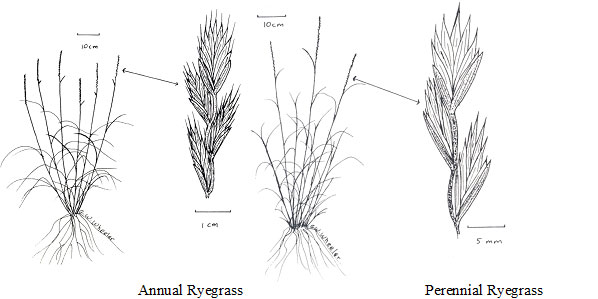
Description of diagram of ryegrasses
Illustration showing annual ryegrass and perennial ryegrass plant parts.
Ryegrasses are bunchgrasses with no creeping growth habit.
Perennial ryegrass (Lolium perenne) grows to approximately 90 cm in height with erect culms. The leaf sheathes are dark green and glabrous, and the leaf blades are folded in the young shoots. Its stems are usually 30 cm to 60 cm tall and are nearly leafless, ending in a stiff, slender spike. The spike is usually slightly curved and up to 30 cm in length. There are up to 35 spikelets per spike which are set at right angles to the stem with 2 to 10 fertile florets per spikelet. The caryopsis of perennial ryegrass is generally awnless.
Annual ryegrass (Lolium multiflorum), also known as Italian ryegrass, has erect culms but is generally taller than perennial ryegrass, reaching up to 130 cm in height. Annual ryegrass also has an abundance of glabrous leaf sheathes but the leaf blades are rolled in the young shoots. The leaves are typically dark green. The spikes are 17 cm to 30 cm long, with up to 38 spikelets per spike and 11 to 22 fertile flowers per spike. Unlike perennial ryegrass, the caryopsis of annual ryegrass is generally awned at various lengths. As with perennial ryegrass, the spikelets are set at right angles to the stem. Italian ryegrass can be distinguished from perennial ryegrass by the characteristic awn and stem and by the arrangement of the leaves as they emerge. As well, annual ryegrass is typically yellow-green at the base, while perennial ryegrass is more often reddish.
Traits useful in distinguishing among varieties:
- leaf colour
- plant growth habit (in spring)
- plant height
- flag leaf width and length
- length of longest stem (including inflorescence)
Spike trisetum (Trisetum spicatum)

Description of diagram of spike trisetum
Illustration of spike trisetum showing roots, spikelike panicle, spikelets and leaves.
Spike trisetum is an erect, densely tufted bunchgrass, without rhizomes, growing 2 inches to 20 inches tall. It flowers July to August.
The seedhead is a dense, spikelike panicle, 1 inches to 4 inches long, that is greenish or purplish in colour. Spikelets are up to 1/4 inch long, numerous, and usually contain 2 florets. Lemmas are short-hairy at the base and 2-toothed at the tip. It has a bent, twisted awn about 3/8 inches long arising from the back of the lemma.
Leaf blades are flat or rolled at maturity, 2 inches to 6 inches long, pubescent to hairy. The sheaths are hairy and ligules are membranous and up to 1/8 inch long. The collar is shaped and serrated on the margin. Auricles are absent. Stems are erect and usually smooth.
Timothy (Phleum pratense)

Swift Current, Saskatchewan: Research Branch, Agriculture Canada.
Source: Tannas, Kathy. Common Plants of the Western Rangelands. Volume 1. Lethbridge, Alberta.
Description of diagram of timothy
Illustration of timothy showing root system, sheath, leaves and cylindrical spike.
Timothy is a perennial bunchgrass characterized by its dense cylindrical spike that may reach up to 15 cm in length and erect stems. Most varieties are 80 cm to110 cm in height and have flat elongated leaves. The spikelets usually have 1 floret. Timothy differs from most grasses in that 1 and sometimes several basal stem internodes become greatly swollen and produce a haplocorm or corm. New shoots develop from buds at the base of the stem below the haplocorm. From these shoots, new stems arise and develop new haplocorms and the old stem or haplocorm dies. Timothy roots are relatively shallow and fibrous. The leaves of timothy are soft, light green, and grow 5 cm to 15 cm long. Its small seeds are enclosed in an awned, urn-shaped husk.
Traits useful in distinguishing among varieties:
- growth habit
- leaf colour and width
- flag leaf length and width
- stem upper internode length
- heading date
- head length
- glume size
- plant height
- time to maturity
Tufted hairgrass (Deschampsia caespitosa)
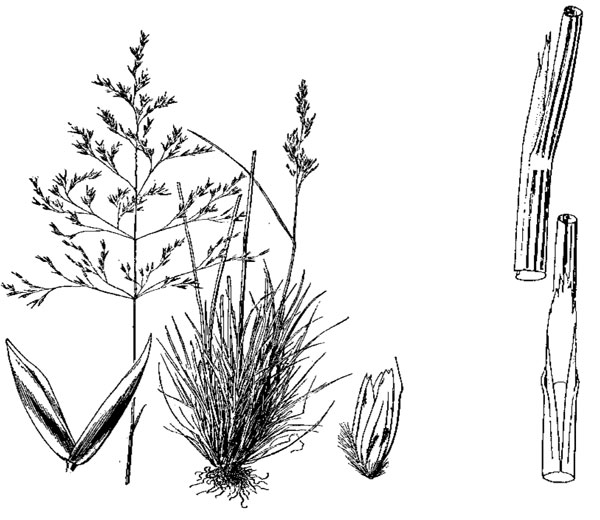
Source: Tannas, Kathy. Common Plants of the Western Rangelands. Volume 1. Lethbridge, Alberta.
Description of diagram of tufted hairgrass
Illustration of hairgrass showing roots, sheath, panicle, spikelets and leaves.
Tufted hairgrass is a perennial bunchgrass with a dense and shallow fibrous root system. It grows from 20 cm to 120 cm tall, and its stems are unbranched. The head is a feathery panicle which has several branches growing in whorls of 6 or 10 at points 2 cm to 3 cm apart. Spikelets are roughly 3 mm long, with awnless glumes as long as the entire spikelet. Each spikelet contains 2 dark brown to black seeds. Tufted hairgrass has abundant, glabrous, narrow leaves which are typically 12 cm to 20 cm in length. The leaves which are usually 1.5 mm to 3 mm wide are folded, and swelling is noticeable where the sheath and blade join.
Traits useful in distinguishing among varieties:
- plant height
- time to flowering
Wheatgrass
Crested wheatgrass (Agropyron cristatum and Agropyron desertorum)
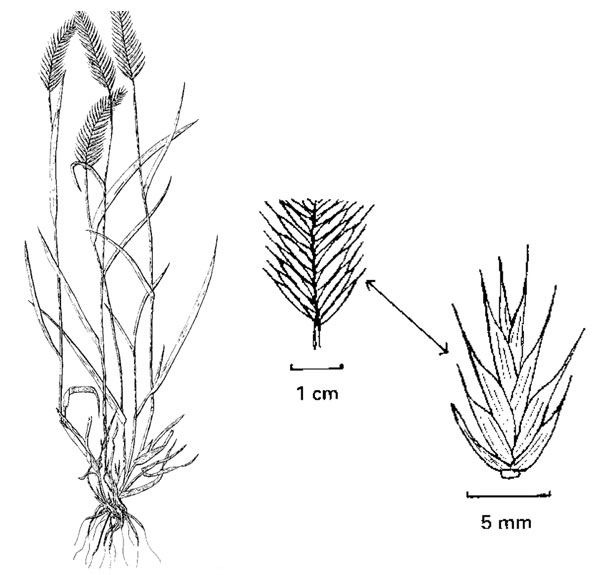
Swift Current, Saskatchewan: Research Branch, Agriculture Canada.
Source: Wheeler, G. 1981. Crested Wheatgrass. Alberta Forage Manual. 4th Edition. Edmonton: Alberta Agriculture.
Description of diagram of crested wheatgrass
Illustration of crested wheatgrass showing roots, leaves and spike.
There are 2 types of crested wheatgrass that exist - the diploid (2n = 14) (Agropyron cristatum) type and the tetraploid standard type (2n = 28) (Agropyron desertorum). The diploid type is shorter, has smaller seeds and finer leaves and stems than the standard type.
Crested wheatgrass is a long-lived, bunch-type grass with a deep, fibrous root system. Stem habit is upright and can reach a height of up to 90 cm. Seeds may or may not have awns.
Traits useful in distinguishing among varieties:
- plant growth habit
- leaf colour, length, width, attitude and pubescence
- time to flowering
- spike length
- stem pubescence
- plant height
Green wheatgrass (Elymus hoffmannii)
Green wheatgrass is a intergeneric hybrid of couchgrass (Elytrigia repens) and beardless wheatgrass (Pseudoroegneria spicata). The seed and plants are very similar in appearance to those of couchgrass. The plants are less vigorous than those of couchgrass.
Intermediate wheatgrass (Elytrigia intermedia formerly Agropyron intermedium)
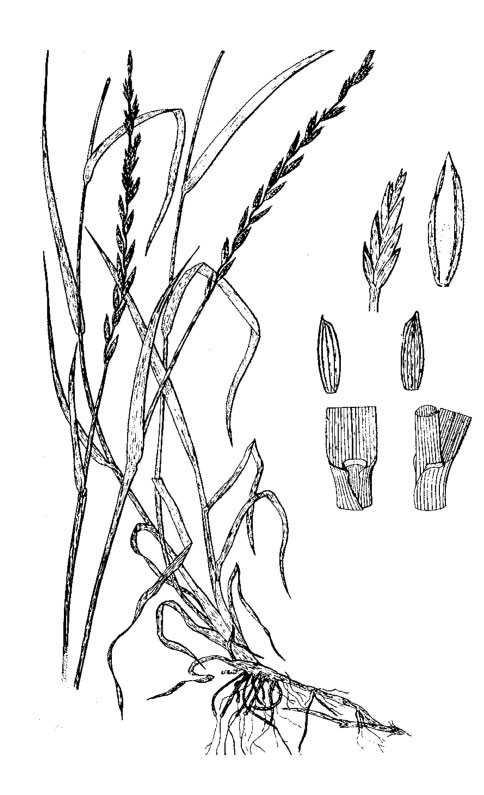
Swift Current, Saskatchewan: Research Branch, Agriculture Canada.
Description of diagram of intermediate wheatgrass
Illustration of intermediate wheatgrass showing roots, sheath, leaves and spikelets.
Intermediate wheatgrass is a short-lived, sod-forming perennial grass. Its extensive deep-feeding root system also has creeping root stalks. It has an erect growth habit with heavy basal leaf growth, and can reach a height of 90 cm to 150 cm by maturity. It can be distinguished from other closely related grasses as many of the leaves have short hairs along the edge. The heads are usually 15 cm to 25 cm long and are typical of wheatgrasses. The seed heads are made up of spikelets spaced at 1 per node, each containing 2 to 6two seeds similar in size to oats. The pointed glumes are half the length of the spikelet.
Traits useful in distinguishing among varieties are:
- plant growth habit
- leaf colour, width, length, attitude and pubescence
- time to flowering
- spike length
- stem pubescence
- plant height
Northern wheatgrass (Elymus lanceolatus formerly Agropyron dasystachyum)

Swift Current, Saskatchewan: Research Branch, Agriculture Canada.
Description of diagram of northern wheatgrass
Illustration of northern wheatgrass showing root system, sheath, leaves and spike.
Northern wheatgrass, also known as thickspike wheatgrass, is a long-lived perennial with a 3-way root system made up of creeping underground rootstocks, a dense shallow root system which penetrates to a depth of about 25 cm, and a couple of deep roots which can penetrate to a depth of at least 60 cm.
Plants are tufted with erect leaves and stems that grow 45 cm to 75 cm high. The leaves are a light greyish-green and are rolled when conditions are dry. Its seed heads are 6 cm to 12 cm long. The seed is generally 50% larger than that of crested wheatgrass.
Traits useful in distinguishing among varieties are:
- plant growth habit
- leaf colour, width, length, attitude and pubescence
- time to flowering
- spike length
- stem pubescence
- plant height
Pubescent wheatgrass (Agropyron trichophorum)
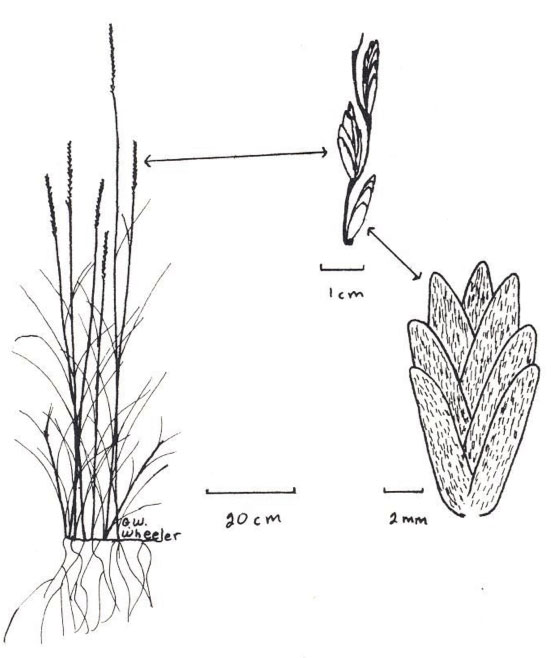
Description of diagram of pubescent wheatgrass
Illustration of pubescent wheatgrass showing roots, leaves and spike.
Pubescent wheatgrass is a long-lived, sod-forming grass which closely resembles intermediate wheatgrass, but can be distinguished by the presence of short stiff hairs (pubescence) on its heads and seeds. The 2 species reproduce together easily, resulting in a gradual grading between the 2 species (that is, there are plants which carry traits of both and appear to be a mix of the 2). Because of this grading, it has been suggested that they should be called the same species (Agropyron intermedium). However, pubescent wheatgrass is both more drought tolerant and longer lived than intermediate wheatgrass.
It has an erect growth habit with heavy growth of basal leaves. Its stems grow to a height of 90 cm to 150 cm with seed heads that are 10 cm to 20 cm long. The plant, seed heads, and seed are all somewhat hairy.
Traits useful in distinguishing among varieties are:
- plant growth habit
- leaf colour, width, length, attitude and pubescence
- time to flowering
- spike length
- stem pubescence
- plant height
Siberian wheatgrass (Agropyron sibericum, Agropyron fragile)
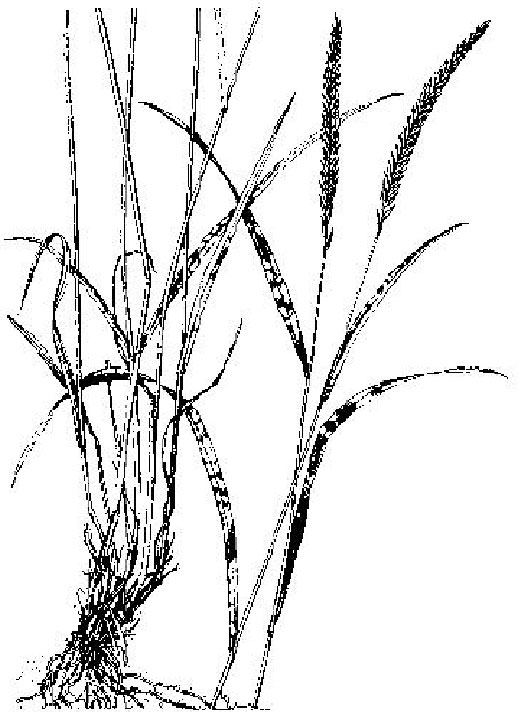
Description of diagram of Siberian wheatgrass
Illustration of Siberian wheatgrass showing roots, leaves and spike.
Siberian wheatgrass is a long-lived, drought-resistant bunchgrass. It is similar to crested wheatgrass, but has finer stems and more narrow seed heads with awnless glumes. As well, its leaves are more lax, and it tends to mature later than standard crested wheatgrass.
Traits useful in distinguishing among varieties are:
- plant height
- time to flowering
Slender wheatgrass (Elymus trachycaulus formerly Agropyron trachycaulum)
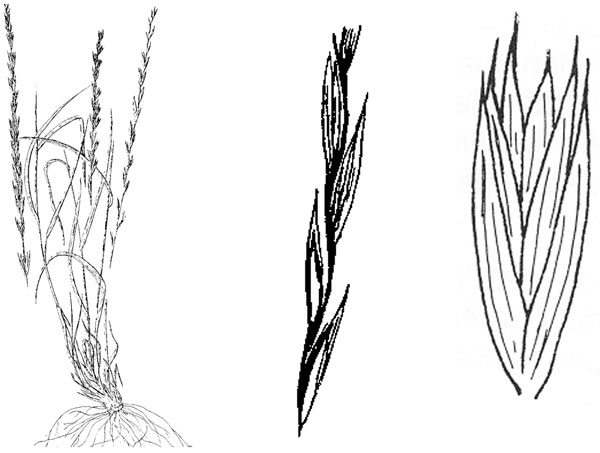
Source: Looman, J. 1983. 111 Range and Forage Plants of the Canadian Prairies.
Swift Current, Saskatchewan: Research Branch, Agriculture Canada.
Description of diagram of slender wheatgrass
Illustration of slender wheatgrass showing roots, leaves and spike.
Slender wheatgrass is a native, short-lived, perennial bunchgrass. It has a leafy, bunch growth habitat and a dense, fibrous root system that extends to a depth of 50 cm. Its bunches enlarge by tillering. Stems have an erect growth habit and are rather coarse. Seed stalks are 60 cm to 120 cm tall and have numerous leaves and spikes that are either dense or very open. Short awns extend from the seed hulls. Almost all plants have a reddish or purple colouring of the stems near their base. Leaves grow up to 30 cm long and 1.2 cm wide. It can be distinguished from other wheatgrasses by its slender seed head and larger seed.
Traits useful in distinguishing among varieties are:
- plant growth habit
- leaf colour, width, length, attitude and pubescence
- time to flowering
- spike length
- stem pubescence
- plant height
Streambank wheatgrass (Elymus lanceolatus formerly Agropyron riparium)
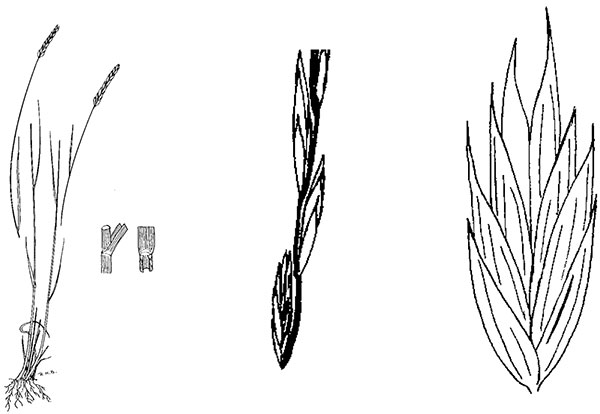
Source: Looman, J. 1983. 111 Range and Forage Plants of the Canadian Prairies.
Swift Current, Saskatchewan: Research Branch, Agriculture Canada.
Description of diagram of steambank wheatgrass
Illustration of steambank wheatgrass showing roots, leaves and spike.
Streambank wheatgrass is a cool-season, long-lived grass. It resembles northern wheatgrass, but can be distinguished by its lack of hair on its seed heads and seeds, and narrower leaves. The numerous slender rhizomes of streambank wheatgrass are more vigorous than those of northern wheatgrass. In the past the 2 have been considered to be the same species, but now are generally recognized as being distinct. The leaves are a light greyish-green, tough, narrow and smooth, 10 cm to 25 cm long and can be somewhat curled at the margins. The stems grow to 90 cm high. The seed head is 5 cm to 10 cm long, and its seeds are somewhat larger than those of crested wheatgrass.
Traits useful in distinguishing among varieties are:
- plant growth habit
- leaf colour, width, length, attitude and pubescence
- time to flowering
- spike length
- stem pubescence
- plant height
Tall wheatgrass (Elytrigia elongata formerly Agropyron elongatum)

Swift Current, Saskatchewan: Research Branch, Agriculture Canada.
Description of diagram of tall wheatgrass
Illustration of tall wheatgrass showing roots, leaves, sheath and spikelets.
Tall wheatgrass is a late maturing, coarse bunchgrass that grows by producing tufts on short rootstocks at the edge of mature plants. It has long, light-green, coarse basal leaves which surround several leafy stems that are 80 cm to 200 cm tall. Its seed heads are similar to those of intermediate wheatgrass, but are generally longer, from 15 cm to 25 cm in length. Unlike with western wheatgrass, the spikelets do not overlap. The spikelets and the 4 to 10 enclosed seeds grow away from the stem like a sickle. Its seeds which are contained in glumes which are square across the tip are somewhat larger than that of intermediate wheatgrass, but tends to have a lower germination.
Traits useful in distinguishing among varieties are:
- plant growth habit
- leaf colour, width, length, attitude and pubescence
- time to flowering
- spike length
- stem pubescence
- plant height
Western wheatgrass (Agropyron smithii)
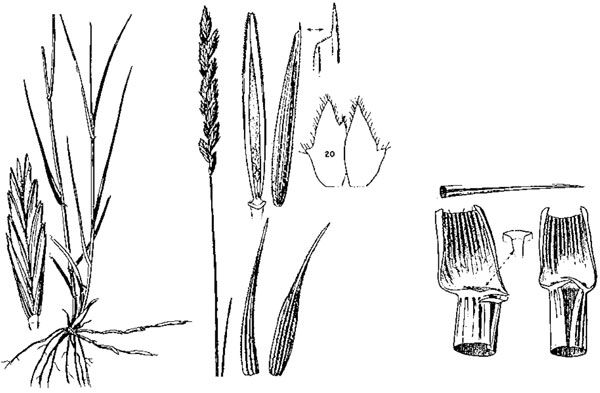
Description of diagram of western wheatgrass
Illustration of western wheatgrass showing roots, leaves, sheath and spike.
Western wheatgrass is also known as bluejoint. It has a well-developed root system made up of a mass of surface roots which feed to a depth of 20 cm and a set of deep feeding roots which can penetrate to a depth of up to 150 cm. It is very hardy and spreads by underground rhizomes.
The leaves of western wheatgrass are 20 cm to 30 cm long, and grow at a 45 degree angle to the stem. The plant as a whole grows 60 cm to 90 cm high. Its leaves are blue-green and more or less stiff and erect. The entire plant is covered with a greyish bloom, giving it a distinct colouration. Seed heads are 5 cm to 15 cm long, and the seed is roughly twice as large as that of crested wheatgrass.
Traits useful in distinguishing among varieties are:
- plant growth habit
- leaf colour, width, length, attitude and pubescence
- time to flowering
- spike length
- stem pubescence
- plant height
Wildrye
Altai wildrye (Elymus angustus)
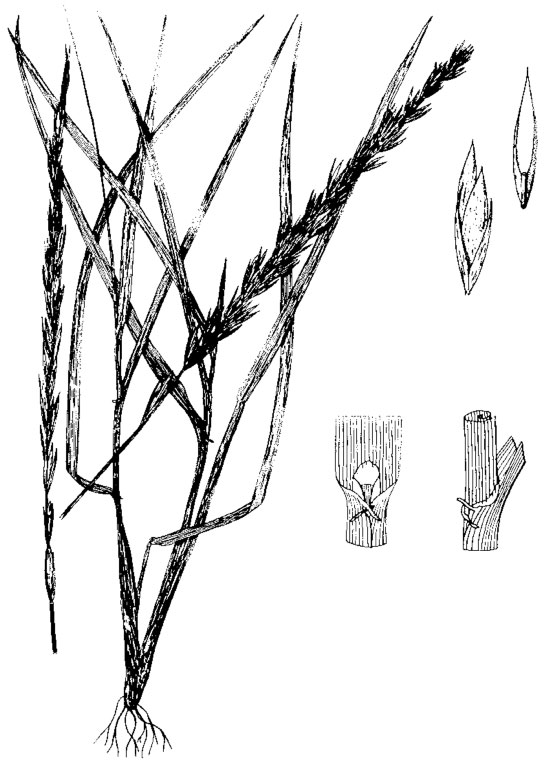
Swift Current, Saskatchewan: Research Branch, Agriculture Canada.
Description of diagram of altai wildrye
Illustration of altai wildrye showing roots, leaves, sheath and spikelets.
Altai wildrye is a long lived perennial bunchgrass. It has a well-developed root system that can penetrate 3 m to 4 m deep. It has coarse stems 60 cm to 120 cm long and coarse, wide, erect basal leaves, light green to blue green in colour which can reach lengths of 40 cm and widths of 12 mm. Its seed heads are 15 cm to 20 cm long with its seeds being 10 mm to 15 mm long, about 3 times larger than those of Russian wildrye.
Beardless wildrye (Elymus triticoides)

Description of diagram of beardless wildrye
Illustration of beardless wildrye showing branched root system and spike.
Beardless wildrye is a perennial, sod-forming grass with a well-branched root system that can reach 1.5 m deep. It has predominately basal leaves and culms that grow from 50 cm to 100 cm in height. This species is also sometimes called "creeping wildrye".
Traits useful in distinguishing varieties:
- plant height
- time to flowering
Dahurian wildrye (Elymus dahuricus)
Dahurian wildrye is a short-lived, perennial bunchgrass with a shallow root system.
Russian wildrye (Elymus junceus)

Source: Looman, J. 1983. 111 Range and Forage Plants of the Canadian Prairies.
Swift Current, Saskatchewan: Research Branch, Agriculture Canada.
Description of diagram of Russian wildrye
Illustration of Russian wildrye showing roots, sheath, leaves and spikelets.
Russian wildrye is a long-lived, large bunchgrass. Its roots are fibrous and can grow to a depth of 3 m. In addition, its wide horizontal spread can be as wide as 1.2 m to 1.5 m around the plant. It has many long, dense basal leaves that are 15 cm to 45 cm long and up to 6 mm wide. The leaves of Russian wildrye vary from light to dark green, with many falling into the blue-green colour range. It has erect, naked stems that grow to 60 cm to 120 cm tall, having a straw colour when mature. The seed head is made up of overlapping spikelets: 2 spikelets at each node contain 1 to 4 or more seeds.
Appendix IV: Descriptions of forage legumes
The following section describes some inspected forage legume species and native plants in terms of characteristics that may be present at the time of inspection. This section also provides the scientific names of the species as they are listed in the Seeds Regulations.
- Alfalfa (Medicago spp.)
- Black medick (Medicago lupulina)
- Birdsfoot trefoil (Lotus corniculatus)
- Clover
- Phacelia (Phacelia tanacetifolia)
- Sainfoin (Obobrychis viciaefolia)
- Vetch
Alfalfa (Medicago spp.)
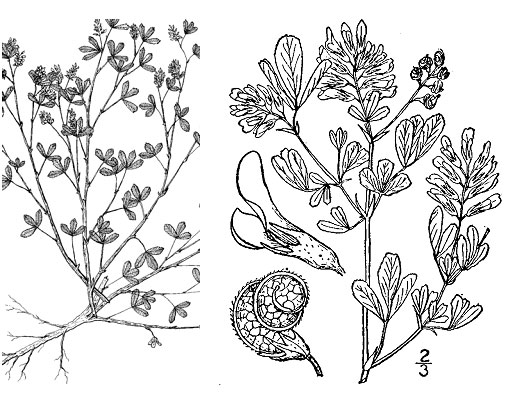
Source: USDA-NRCS Plants Database / Britton, N.L., and A. Brown. 1913. An illustrated flora of the northern United States, Canada and the British Possessions. 3 vols. Charles Scribner's Sons, New York. Vol. 2: 351.
Description of diagram of alfalfa plant
Illustration of alfalfa showing roots, leaflets, flower and pod.
Alfalfa is a widely grown perennial legume with a woody yet narrow crown, taproots and flowers borne on racemes in various shades of blue, purple, cream and white. Pods range in shape from sickle to spiral with 1 or more coils. Leaflets are 9.5 mm to 3.2 cm long, obovate and sharply toothed towards the apex. Traditional varieties are trifoliate, however an increasing number of multi-foliolate varieties (more than 3 leaflets per leaf) have been developed. The erect stems usually reach 30 cm to 90 cm.
Some yellow flowered varieties of M. falcata have been developed; these have a decumbent growth pattern with a deeply set crown and branching roots. The 2 species interpollinate and many varieties of M. sativa contain M. falcata germplasm.
Traits useful in distinguishing among alfalfa varieties:
- growth habit
- plant height
- leaf colour (intensity of green)
- leaflet shape
- percentage of plants with multi-foliolate leaves
- flower colour - % of plants with flowers of a specific colour
- pod shape
- root type like creeping or taproot
Physiological stresses that may affect alfalfa plant appearance:
- soil pH outside of neutral range
- poor drainage
- limited moisture, particularly for tap-rooted types
Black medick (Medicago lupulina)
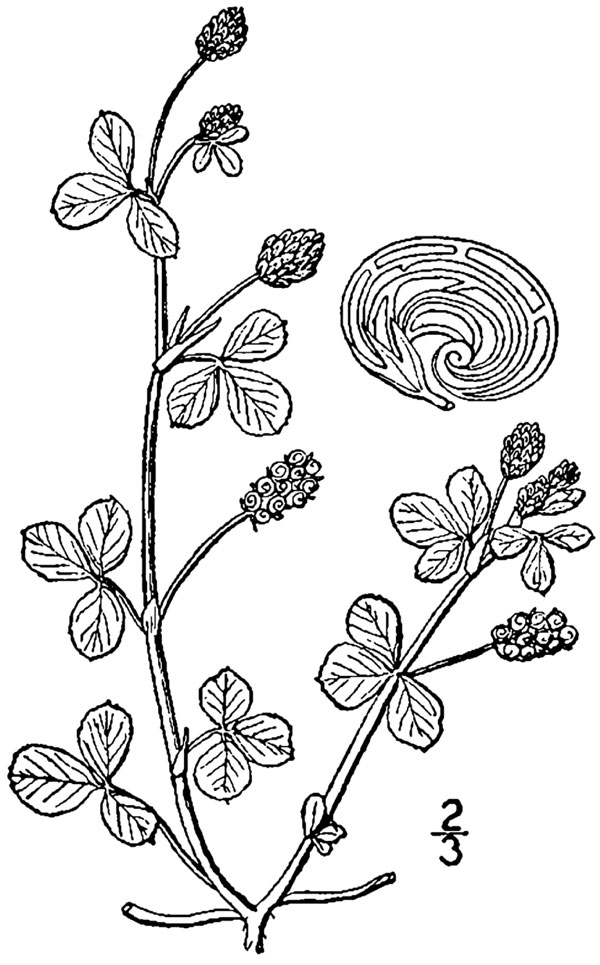
Description of diagram of black medic plant
Illustration of black medic showing trifoliate leaves, cluster flowers and kidney-shaped seed pod.
Black medick is usually an annual plant but in some rare cases, under favourable environments, they can survive as short-lived perennial plants. The roots of this species are in a branching system. The growth habit is prostrate when it reaches maturity; sometimes it grows up to 80 cm. The leaves are green, trifoliate and covered with fine hairs. The small yellow flowers of the black medick are composed of small florets and the shape is similar to the flowers of clovers. The kidney-shaped seedpods are black and usually 3 mm in length. Its distinguishable features are its leaves and the small yellow flower clusters.
Birdsfoot trefoil (Lotus corniculatus)

Source: USDA-NRCS Plants Database / Britton, N.L., and A. Brown. 1913. An illustrated flora of the northern United States, Canada and the British Possessions. 3 vols. Charles Scribner's Sons, New York. Vol. 2: 359.
Description of diagram of birdsfoot trefoil plant
Illustration of birdsfoot trefoil showing compound leaflets, flowers, long and cylindrical seed pods.
Birdsfoot trefoil is a perennial forage with weak roots as a seedling, but that has a strong, well-developed taproot system with many branches once mature. It has several stems arising from the root crown. The slender and moderately leafy stems are usually 60 cm to 90 cm in height, and thinner and more flexible than those of alfalfa. Its compound leaflets close over the petiole and stem in darkness.
The flowers of birdsfoot trefoil vary from light to dark yellow in colour, with 4 to 8 florets. Multiple seed pods that attach to the stem at right angles give it the appearance of a bird's foot. Birdsfoot trefoil pods are long and cylindrical, which turn brown to black and maturity. Due to the proximity of the flowers to the ground, birdsfoot trefoil is capable of reseeding itself even while being closely grazed.
The Common type of birdsfoot trefoil has an early and erect spring growth habit, as well as a rapid seedling and recovery growth. The empire type of birdsfoot trefoil flowers 10 to 14 days later than the Common, and has a semi-erect growth habit.
Traits useful in distinguishing among varieties:
- plant growth habit
- plant height at maturity
- growth type
- stem anthocyanin colouration
- stem pubescence
- time to flowering
- flower keel tip colour
- flower striping
Clover
Alsike Clover (Trifolium hybridum)
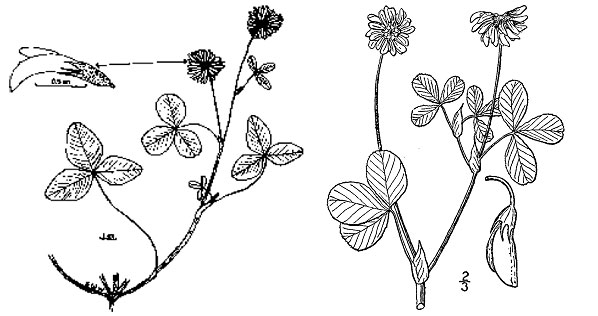
USDA-NRCS Plants Database / Britton, N.L., and A. Brown. 1913. An illustrated flora of the northern United States, Canada and the British Possessions. 3 vols. Charles Scribner's Sons, New York. Vol. 2: 357.
Description of diagram of alsike clover plant
Illustration of alsike clover showing leaflets, flowers and stem.
Varieties of alsike clover are either diploid (2n=16) or tetraploid (2n=32). Diploid types are the most commonly grown. Tetraploid varieties tend to have larger flowers and leaves, and are taller and later maturing than their diploid counterparts. Tillers grow profusely from the crown of Alsike clover, and its stems are at least as long as those of red clover, though more slender and prostrate. It has pink or white flowering heads which are somewhat smaller than those of red clover. Both its leaves and stems are glabrous. It differs from red clover in that the main axis of the stem does not end in a flowering head but rather keeps growing. Flowering branches grow successively from each leaf axil, causing the youngest flowers to be those in the terminal heads and the oldest heads to be located farther down on the stem towards the crown.
Traits useful in distinguishing among varieties:
- time to flowering
- number of internodes on stem
- density of hairs on stem
- length of longest stem (including head)
- stem thickness
- leaf length (central leaflet of the upper normally developed leaf below the terminal flower)
- leaf width
- frequency of plants with white mark on leaves
- stem anthocyanin colouration
- flower colour
- flower head size
Physiological stresses that may affect alsike clover plant appearance:
- heat stress
- drought stress
Prairie Clover (Dalea sp.)

Description of diagram of prairie clover plant
Illustration of prairie clover showing stem, leaflets and flower.
There are 2 types of prairie clover that exist - white and purple.
Purple prairie clover (Dalea purpurea) can grow up to 91 cm tall, with its leaves at the base of its stem. The stem can be ascending or erect, 20 cm to 91 cm long. Leaves are alternate and pinnately compound. The leaves are 1.2 cm to 4.4 cm long, while the leaflets are 1.2 cm to 1.9 cm long and less than 2.5 mm wide. The leaflets have pointed tips, and often have edges which roll inwards towards their upper side. Flowers are purple or pinkish with 5 stamens.
White prairie clover (Dalea candida) grows to 45 cm to 60 cm high. It is usually unbranched or only sparsely branched. Its central stem is light green and has longitudinal lines running up it. Leaves are alternate and pinnately compound, with 3 to 9 leaflets per leaf. Leaflets are either linear or narrowly oblanceolate. The leaflet margins are smooth, and there are numerous translucent dots on the underside of each leaf. Flowers are arranged on a 2.5 cm to7.6 cm spike found at the end of each major stem. Each flower is white, with 5 petals and 5 white stamens. The root system includes a central taproot which can go as deep as 1.5 m down into the earth.
The 2 types of prairie clover can be distinguished by the length of the flowering spikes (usually longer in white prairie clover), and the foliage (lighter, longer and more sparse in white prairie clover).
Traits useful in distinguishing among varieties:
- leaflet length
- time to flowering
Red Clover (Trifolium pratense)
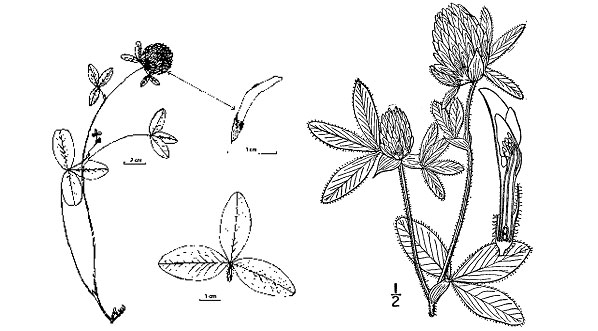
USDA-NRCS Plants Database / Britton, N.L., and A. Brown. 1913. An illustrated flora of the northern United States, Canada and the British Possessions. 3 vols. Charles Scribner's Sons, New York. Vol. 2: 355.
Description of diagram of red clover plant
Illustration of red clover showing 3 pubescent oblong leaflets, stem and flower.
There are 2 types of red clover that exist: single and double cut. Most varieties grown in Canada are of the double cut type. It has a taproot system as well as many secondary branches.
Red clover plants are composed of numerous leafy stems arising from a crown. The stems and leaves of American strains are generally pubescent while European strains are glabrous. Each leaf is made up of 3 oblong leaflets usually bearing a characteristic white or pale green, inverted "V" leaf markings in the centre of each leaflet (Heath et al., 1978). The heads are compact clusters of up to 125 flowers. Under favourable conditions, these flowers are 9 mm to 10.5 mm long (Heath et al., 1978). Flower colour varies from magenta to pale pink.
Traits useful in distinguishing among varieties:
- time to flowering
- number of internodes on stems during flowering
- density of hairs on stem
- flower colour
- leaf size
- intensity of watermark
Sweetclover (Melilotus albus and Melilotus officinalis)

Description of diagram of sweetclover plant
Illustration showing plant parts of yellow sweetclover and white sweetclover.
Sweetclover is typically a biennial legume, with a deeply penetrating taproot similar to that of alfalfa. It has trifoliate leaves, with leaflets that tend to be toothed around the margin (as opposed to only at the tip as in alfalfa). Sweetclovers have small and narrow stipules. Seed pods typically contain 1 seed but occasionally have 2.
There are 2 types of sweetclover that exist; white sweetclover (M. albus) and yellow sweetclover (M. officinalis). White sweetclover is taller and has coarser leaves and stem than yellow sweetclover. Yellow sweetclover has a finer stem and matures earlier than the white sweetclover.
Traits useful in distinguishing among varieties:
- plant growth habit
- plant spring vigour
- leaf size
- leaflet size (yellow sweetclover only)
- leaf colour
- stem thickness
- time to flowering
- flower colour
- flower size
- plant height
White Clover (Trifolium repens)
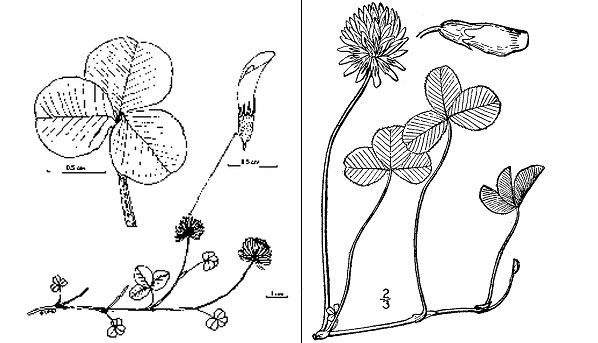
USDA-NRCS Plants Database / Britton, N.L., and A. Brown. 1913. An illustrated flora of the northern United States, Canada and the British Possessions. 3 vols. Charles Scribner's Sons, New York. Vol. 2: 358.
Description of diagram of white clover plant
Illustration of white clover showing flower, 3 leaflets and stem.
White clover is a short to long lived perennial with a shallow taproot system and very small crowns. The primary stems are short with many internodes. Its flowers are usually white, though occasionally they are tinged with pink. The flowers of white clover are borne on peduncles that are somewhat longer than the petioles. There are 20 to 150 florets per head. Each leaf has 3 leaflets, and each leaflet usually has a v-shaped white mark in its centre. The leaflets are usually elliptical to heart shaped. The seeds of white clover are small and yellow. Its stems are glabrous, have a prostrate growth habit, and grows to 30 cm to 45 cm tall. The stolon of white clover is solid.
The species is highly polymorphic resulting in a great deal of variation in plant and plant part size.
Traits useful in distinguishing among varieties:
- time to flowering
- leaf length (central leaflet of the upper normally developed leaf below the terminal flower)
- leaf width
- frequency of plants with white marks on leaves
- length of petiole
- thickness of stolon
Phacelia (Phacelia tanacetifolia)
Phacelia tanacetifolia is a versatile plant that is used extensively in Europe, both as a cover crop and as bee forage. It is a herbaceous, non-leguminous, flowering annual.
Phacelia grows to a height of between 6 inches and 47 inches and has bristly stems and hairy, dark green leaves which grow to 5 inches long. The leaves appear ferny and the flowers appear in flat-topped clusters in various shades of purple, blue and occasionally white. The bell shaped flowers have 5 rounded petal ups to ¼ inch wide.
Sainfoin (Obobrychis viciaefolia)

Swift Current, Saskatchewan: Research Branch, Agriculture Canada.
Description of diagram of sainfoin plant
Illustration of sainfoin showing taproots, leaflets and flowers.
Sainfoin is a deep-rooted legume that usually grows taller than alfalfa, to a height of 1 m or more. The stems of sainfoin are upright and hollow, but appear very succulent, and it has a root system consisting of deep taproots with many side branches.
The leaves have 6 to 14 pairs of leaflets which are more or less hairy. The flowers are large and either rosy pink or white in colour, and appear on spike-like heads up to 15 cm long, 1 to 2 weeks before alfalfa blossoms. The flowers are characteristic of this crop. Pods which are less than 1 cm long, hairy, and toothed on the margins contain single seeds, roughly 3 mm in length, shatter as they mature.
Traits useful in distinguishing among varieties:
- plant growth habit
- plant canopy
- size of secondary leaf
- leaf colour
- leaf hair type
- plant height
- time to flowering
- flower colour
Vetch
Cicer Milkvetch (Astragalus cicer)
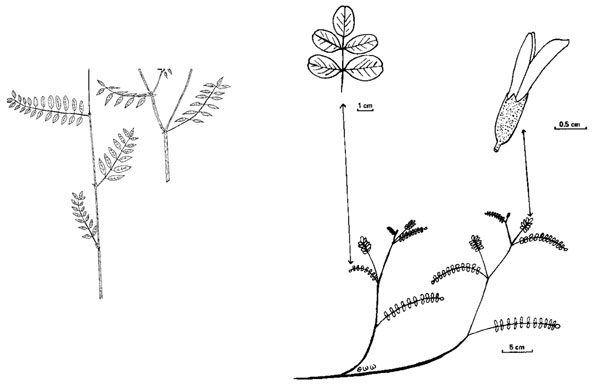
Source: Looman, J. 1983. 111 Range and Forage Plants of the Canadian Prairies.
Swift Current, Saskatchewan: Research Branch, Agriculture Canada.
Description of diagram of cicer milkvetch plant
Illustration of cicer milkvetch showing compound leaflets, stem and flower.
Cicer milkvetch is a long-lived, perennial legume with a deep, vigorous root system which may be as wide as 120 cm in good conditions. While growth is upright when young, the stems tend to droop down as the plant matures. Plant height rarely exceeds 60 cm, even though the stems may be up to 120 cm long. Its stems are succulent, coarse and hollow. Leaves are divided into many leaflets (usually 10 to 13 leaflets plus 1 terminal leaflet per leaf). Flowers are white to pale yellow, and are borne on racemes. There are 20 to 60 flowers per raceme. The pods are pale yellow to white when young, turning black and leathery as the seeds mature. The seeds are flattened, very hard and roughly twice as large as those of alfalfa, with 3 to 11 seeds per pod.
Traits useful in distinguishing among varieties:
- time to flowering
- flower colour
- plant height
Crownvetch (Coronilla varia)
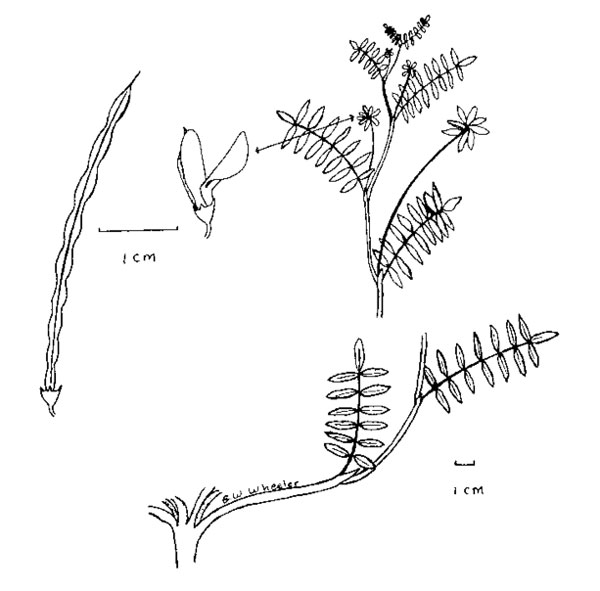
Description of diagram of crownvetch plant
Illustration of crownvetch showing compound leaflets, pod and flower.
Crownvetch is a perennial that derives its name from its vetch-like leaves and crown-shaped flower arrangement. It has a deep and branching taproot with many fleshy creeping roots that can develop to a length of 3 m or more.
Flowers are a variegated white to purple colour and are borne on angular, decumbent to ascending hollow stems ranging from 30 cm to 120 cm in length. The pods are long and cylindrical with 3 to 12 segments. Its leaves are alternate and pinnately compound, with 9 to 25 leaflets per leaf.
Traits useful in distinguishing among varieties:
- plant growth habit
- plant canopy size
- size of secondary leaf
- leaf colour
- leaf hair type
- plant height
- time to flowering
- flower colour
Canadian Milkvetch (Astragalus canadensis)

Description of diagram of Canadian milkvetch plant
Illustration of Canadian milkvetch showing odd-pinnately compound leaves and stem.
Canadian milkvetch is a perennial legume with underground rhizomes. Plants of this species may be large and robust once established, with plant height ranging from 12 inches to 40 inches. The leaves are odd-pinnately compound; leaflets are medium green, 1 cm to 4 cm long, and 5 mm to 15 mm wide. Generally, they are smooth or slightly hairy on the upper surface with stiff, short hairs on the underside.
The flowers are creamy, greenish white and about 1/2 inch to 3/4 inch long in a dense spike-like head. Flowering occurs from May to August. The pods contain several seeds that are small, smooth, and brownish yellow-green.
Chickling Vetch (Lathyrus sativus)

Description of diagram of chickling vetch plant
Illustration of chickling vetch showing flower colour, linear leaflets, branched tendrils and legume pod.
Chickling vetch also known as azure blue sweet pea, Indian vetch and grass pea is bushy-vined annual with 1 to several upright winged stems to 1 m high. The leaves consist of 1 to 2 pairs of linear leaflets 2 cm to 15 cm long and 3 mm to 7 mm wide. Leaves end with a branched tendril.
The flowers are located in upper leaf axils and are bluish-purple or occasionally white. The flowers are 12 mm to 24 mm in diameter (pea-like).
The legume pod is 1 cm to 1.8 cm wide, 2 cm to 4 cm long and contain 2 to 4 seeds. The seeds are typically 6.0 mm to 8.0 mm in diameter, and can be beige to dark brown in colour. Usually, the seeds are heavily speckled dark brown to black.
It is grown as a cover crop. There are no visual characteristics that distinguish varieties.
- Date modified:
